STANLEY KUBRICK'S Full Metal Jacket
Shot-by-Shot Analysis
Part Two
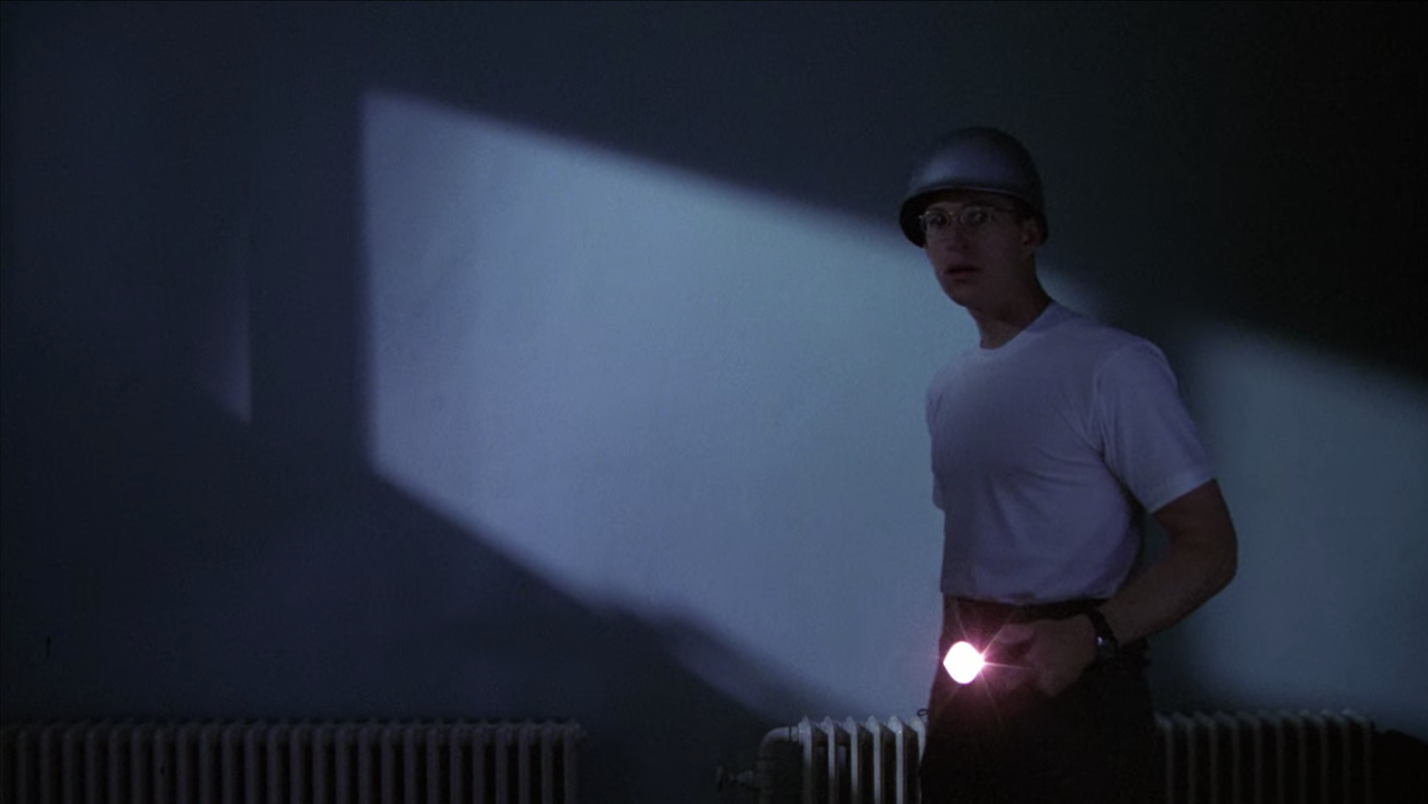
Go to TOC for this film ( (which has also a statement on purpose and manner of analysis and a disclaimer as to caveat emptor and my knowing anything authoritatively, which I do not, but I do try to not know earnestly, with some discretion, and considerable thought).
TOC and Supplemental Posts | Part 1 | Part 2 | Part 3 | Part 4 | Part 5 | Part 6 | Part 7 | Part 8 | Films Home
LINKS TO SECTIONS OF THE ANALYSIS ON THIS PAGE:
Helping Private Pyle, Shots 106 through 116
The Jelly Doughnut, Shots 117 through 128
The Bad Dream, Shots 129 through 136
The Motivated Marine, Shots 137 through 167
Graduation, Shots 168 through 182
Malfunction, Shots 183 through 214
106 Exterior. MS of Joker sitting on a bench with Pyle, instructing him on his rifle. Begin "Parris Island" score. (19:28)
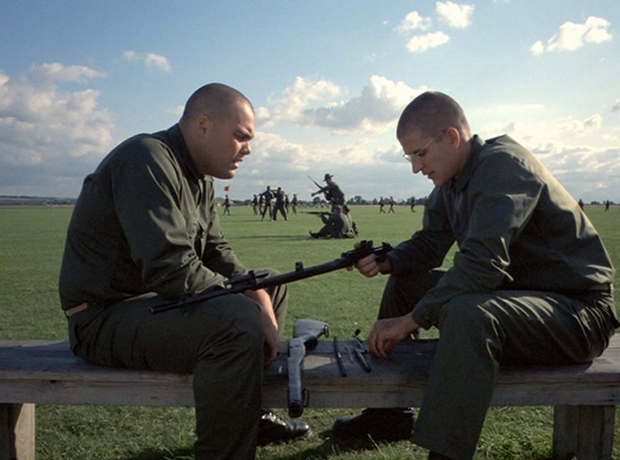
JOKER: The bolt. The bolt goes in the receiver. Operating-rod handle. Operating-rod guide.
107 Interior of squad bay. Joker instructs Pyle on how to lace up his shoes. Cowboy and the other recruits are observed beyond, buffing their boots, Hartman overseeing. Joker and Pyle have already polished and shined their boots, (19:42)
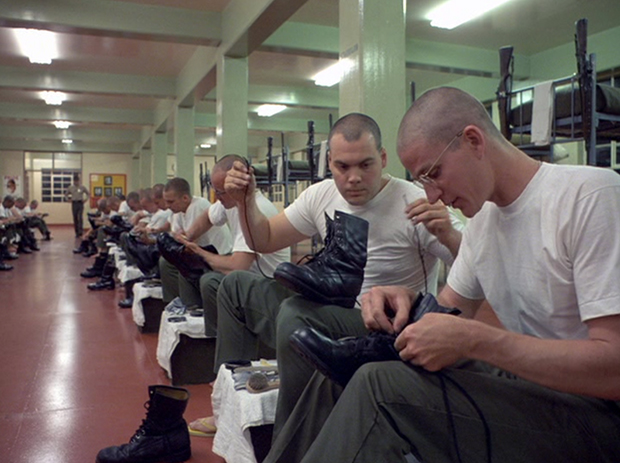
JOKER: The left one over the right. Right one over the left. Left one over the right. The right one over the left.
108 Joker sits on the top rung of the Stairway to Heaven, coaching Pyle up and over it. Unlike when Pyle was on the Stairway to Heaven with Hartman, there are no other recruits ascending and descending. We observe recruits in the background, down on the field, working other obstacles. (19:56)
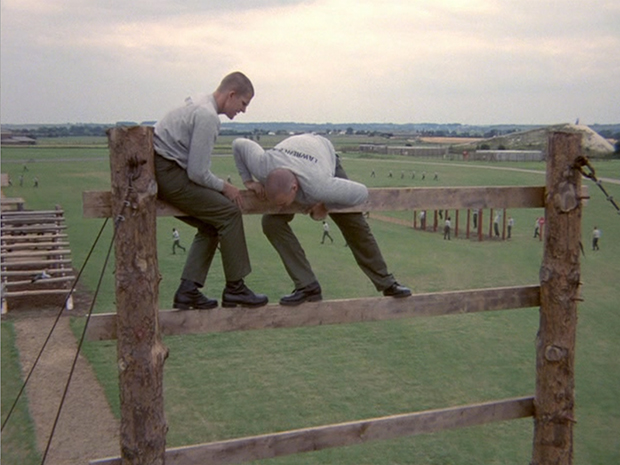
JOKER: Just throw your other leg over. Attaboy. That's it. Now just pull the next one over and you're home free. Ready? Just throw it over. Attaboy. Set it down. All right? There you go. Congratulations, Leonard. You did it.
109 Joker instructs Pyle on making the bed. In the background, the other recruits are at work making their beds, Hartman again observing. (20:46)

JOKER: Fold the blanket and the sheet back together. Make a four-inch fold. Okay? Got it? You do it.
110 Joker drills Pyle. We see the rest of the platoon marching beyond them. (20:57)
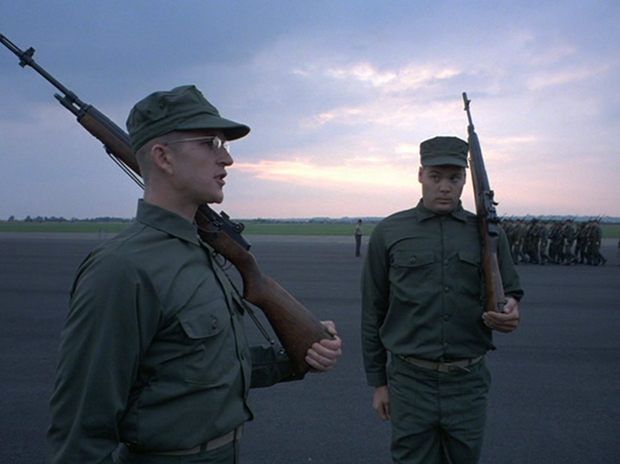
JOKER:
Right shoulder. Hut!
We hear Hartman training the other recruits in the background.
HARTMAN: Your left shoulder.
JOKER: Port. Hut! Order .Hut.
111 Slow motion of Cowboy, Joker and Pyle using ropes to jump a trench together. We see Hartman overseeing, standing to the side above the trench. (21:17)
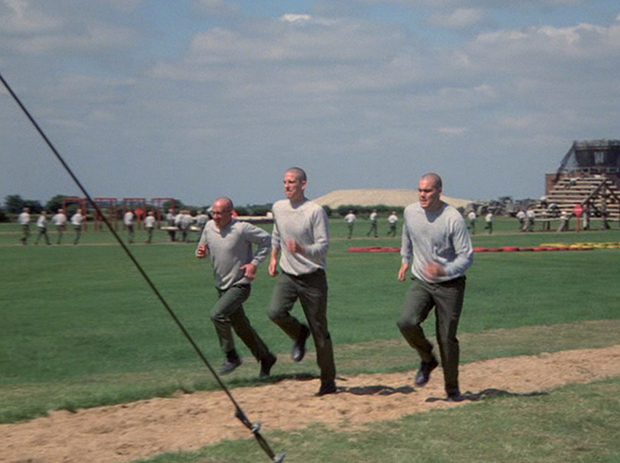
112 LS of platoon doing marching drill with Hartman. Pyle leads the screen-right column, Joker the 2nd from the right, and Cowboy the 3rd from the right, of four columns. (21:28)
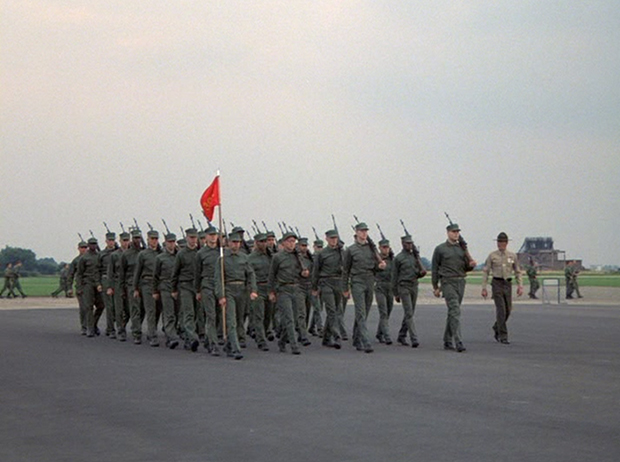
HARTMAN (chants): Your right shoulder. Hut! (Off screen.) Square these weapons away. My Corps' arms should be parallel to the...
113 Begin slow crossfade to firing range that is two banks of 6 targets each, 1 through 6 and 7 through 12, and an extreme zoom out across the range. As the extreme zoom out takes place the 8 and 11 targets are changed from A (200-300 m/y slow fire) to D (200-300 m/y rapid fire) targets, and then changed so 7 is D, and when we can see the left bank we see 5 is a D target. The zoom out progresses to show the individuals who are shooting, to show two behind seated on boxes marked 7 and 8, recruits waiting on benches to practice shooting, and then further out, we come to see Hartman lecturing his recruits. (21:45)
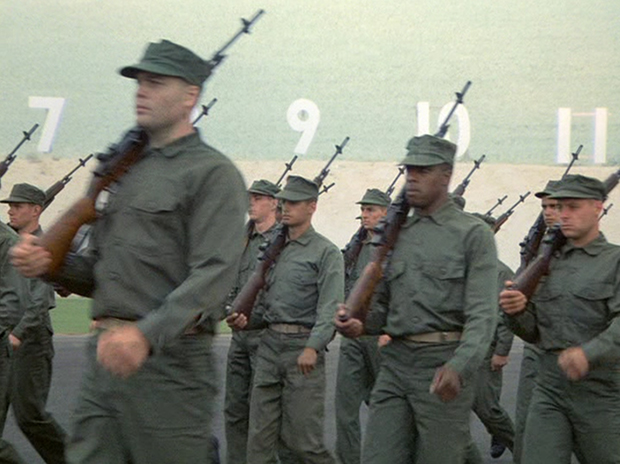
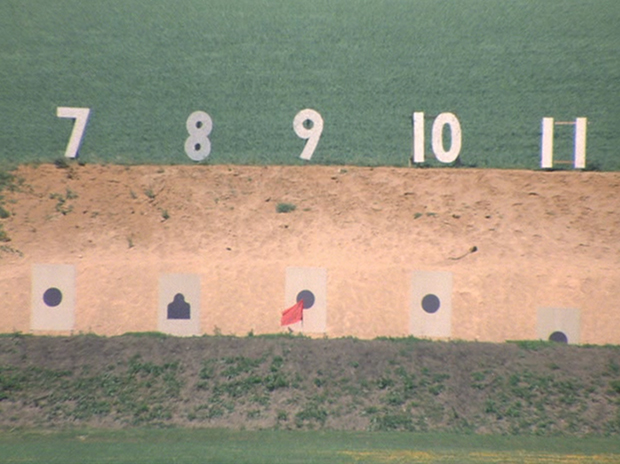
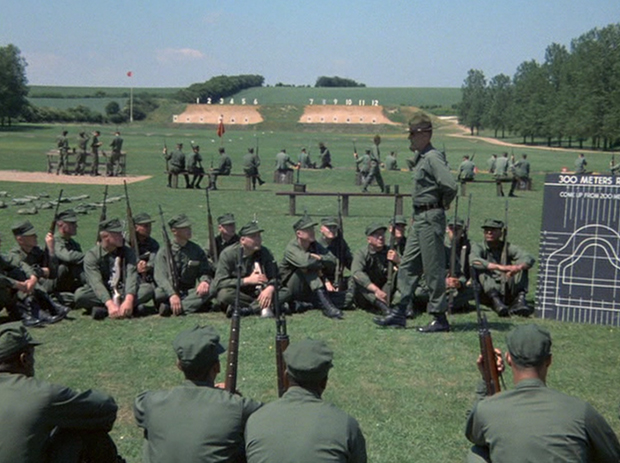
HARTMAN: The deadliest weapon in the world is a Marine and his rifle. It is your killer instinct which must be harnessed, if you expect to survive in combat. Your rifle is only a tool. It is a hard heart that kills.
114 Hartman instructing soldiers on rifles (22:18)
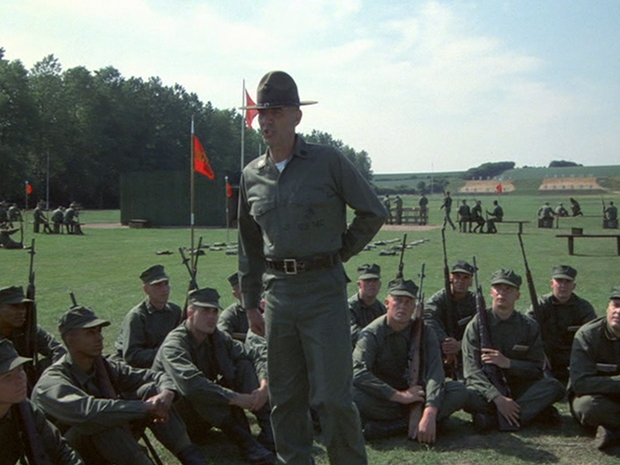
HARTMAN: If your killer instincts are not clean and strong, you will hesitate at the moment of truth. You will not kill. You will become dead-Marine, and then you will be in a world of shit, because Marines are not allowed...
115 Medium profile shot of Pyle, Joker and Cowboy watching. (22:39)
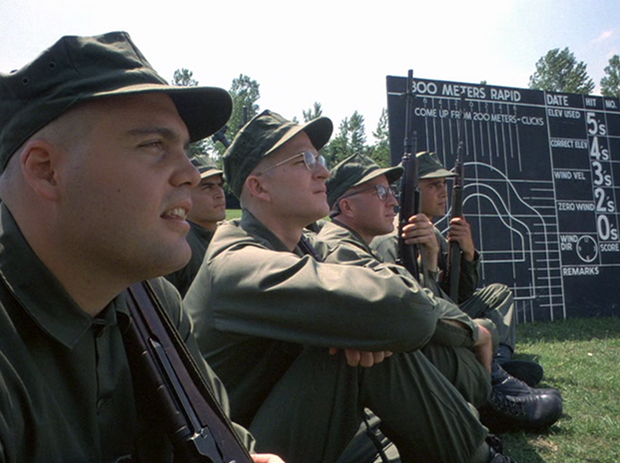
HARTMAN (off screen):
to die without permission. Do you maggots understand?
RECRUITS:
Sir, yes, sir.
116 MLS of platoon jogging with Hartman. Joker leads the screen-right column, then Joker 2nd to right, then Pyle 3rd to right in four columns. (22:44)
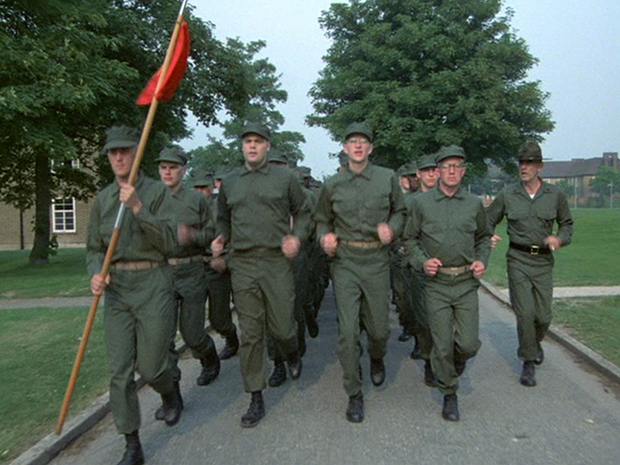
HARTMAN (calling cadence):
I love working for Uncle Sam
RECRUITS:
I love working for Uncle Sam
HARTMAN:
Lets me know just who I am
RECURUITS:
Lets me know just who I am
HARTMAN:
One, two, three, four, United States Marine Corps
RECRUITS:
One, two, three, four, United States Marine Corps
HARTMAN:
One, two, three, four, I love the Marine Corps
RECRUITS:
One, two, three, four, I love the Marine Corps
HARTMAN:
My Corps
RECRUITS:
My Corps
HARTMAN:
Your Corps
RECRUITS:
Your Corps
HARTMAN: Our Corps
RECRUITS:
Our Corps
HARTMAN:
Marine Corps
RECRUITS:
Marine Corps
HARTMAN:
I don't know, but I've been told
RECRUITS:
I don't know, but I've been told
HARTMAN:
Eskimo pussy is mighty cold
RECRUITS:
Eskimo pussy is mighty cold
HARTMAN:
Mmm, good
RECRUITS:
Mmm, good
HARTMAN:
Feels good
RECRUITS:
Feels good
HARTMAN:
ls good
RECRUITS:
Is good
HARTMAN:
Real good
RECRUITS:
Real good
HARTMAN:
Tastes good
RECRUITS:
Tastes good
HARTMAN:
Mighty good
RECRUITS:
Mighty good
HARTMAN:
Good for you
RECRUITS:
Good for you
HARTMAN:
Good for me
RECRUITS: Good for me
The Stairway of Heaven shot of 108 shows Pyle completing the climb that was aborted in shot 91, Pyle unable to manage the climb for Hartman. 111 is a slow motion shot of Pyle's successful leap of the trench alongside Joker and Cowboy, and the only other slow motion shot thus far was 95, concluding the other obstacle course scene, in which Pyle was having difficulty making his way though the mud pit, dragging down Joker, and Cowboy joining in to try to help pull Pyle up. So this obstacle course section shows Pyle able to perform more ably than before. Joker's retraining of Pyle is depicted as successful. Pyle learns not by bullying but by watching and mimicking Joker, who is himself a good mimic and had attracted Hartman's attention initially with his question posed in a John Wayne voice that was intended to disrupt Hartman's abuse of Snowball. Pyle's attentiveness can at times be only described as child-like, tentative yet eager to learn, but with shots of him as part of the group he looks engaged, secure. Note that these shots suggest Joker's training Pyle as possibly a grace period in which Pyle otherwise suffers no abuse, receiving only encouragement and praise from Joker.
If one is familiar with Kubrick's films, watching the firing range scene one may be reminded of the hiring of Nikki, in The Killing, to be the sniper who shoots a horse during a race at the track, and Johnny's visit with Nikki where we observe Nikki shooting targets. Perhaps coincidentally, in Full Metal Jacket, the first firing range scene occupies shots 113 through 115, while in The Killing the target practice scene occupies shots 116 through 124. The target scene practice in The Killing shows, in shot 116, the 3 targets facing Nikki and away from a field as he shoots. After Nikki ceases shooting, the camera moves to the reverse side of the targets to film Nikki and Johnny standing beside them, and the targets have reversed so they are facing the viewer rather than Nikki and Johnny. This is intentional as continuity could have been very easily preserved.
Though Nikki succeeds in shooting, from his car in a parking lot, the horse at the race track, he then is quickly shot by a guard due his inability to get away as a horse shoe punctures a wheel of his car.
We can draw a correspondence between this extreme zoom-out, from the targets, over the recruits practicing their shooting, to Hartman lecturing his platoon, with the extreme zooms that we have from the sniper perspective, and one very quick zoom-in on the sniper's window. Otherwise, there is one other extreme zoom-out that occurs in the film, with the shot that begins on Joker's face, in close-up, then zooms out to show the long line of Vietnamese bodies in a trench, covered in white lime.
In the book, the "Eskimo" cadence occurs in the sixth week, before Pyle's being abused by the platoon at the beginning of the 7th week, at the same time they are ordered to name their rifles.
During our sixth week, Sergeant Gerheim orders us to double-time around the squad bay with our penises in our left hands and our weapons in our right hands, singing: This is my rifle, this is gun; one is for fighting and one is for fun. And: I don't want no teen-aged queen; all I want is my M-14.
Sergeant Gerheim orders us to name our rifles. "This is the only pussy you people are going to get. Your days of finger-banging ol' Mary Jane Rottencrotch through her pretty pink panties are over. You're married to this piece, this weapon of iron and wood, and you will be faithful."
We run. And we sing:
Well, I don't know
But I been told
Eskimo pussy
Is mighty cold...
The "This is my rifle, this if my gun" counting cadence, in the film, has already been depicted in shot 76, between the night prayer scene, shots 61 through 74, and the first extensive sequence of training on the obstacle course.
I don't know the origin of the Eskimo cadence but it was popularly believed that Eskimo was derived from an Algonquin term meaning "eaters of raw meat" and was considered derogatory. The "eaters of raw meat" has been postulated to derive from the Inuit diet including such things as raw seal meat. In the book, Rafter Man at one point puts a piece of flesh in his mouth, of a fellow Marine who had been exploded, and astonishes Joker by devouring it. Rafter Man is, as yet, inexperienced, but he is one who has been eager to get into the "shit". It would seem he is in shock but he's responding to an earlier incident in which he was mocked for appearing aghast when Mr. Payback, after a battle with rats, bites off a piece of rat tail, offers Rafter Man a bite, then asks Rafter Man if he doesn't want to be a killer when he is too astonished to respond. Eating the man's flesh is Rafter Man proving he wants to be and can be a killer and is even tougher than Mr. Payback. Later, in both the book and the film Rafter Man glories over shooting the female sniper in a manner Kubrick's camera highlights and questions. So the cadence of the Marines and how the taste is good...what is already uncomfortable for its racism and misogyny becomes even more messy when one brings in the "eaters of men" origin of the Eskimo term.
After the green ghouls from graves registration stuff Winslow into a body bag and take him away, we go back to our hootch. We flop on our racks, wasted.
I say, "Well, Rafter, now you've heard a shot fired in anger."
Soaking wet in green skivvies, Rafter Man is sitting on his rack. He has something in his hand. He's staring at it.
I sit up. "Hey, Rafter. What's that? You souvenir yourself a piece of shrapnel?" No response. "Rafter? You hit?"
Mr. Payback grunts. "What's wrong, New Guy? Did a few rounds make you nervous?"
Rafter Man looks up with a new face. His lips are twisted into a cold, sardonic smirk. His labored breathing is broken by grunts. He growls. His lips are wet with saliva. He's looking at Mr. Payback. The object in Rafter Man's hand is a piece of flesh, Winslow's flesh, ugly yellow, as big as a John Wayne cookie, wet with blood. We all look at it for a long time.
Rafter Man puts the piece of flesh into his mouth, onto his tongue, and we think he's going to vomit. Instead, he grits his teeth. Then, closing his eyes, he swallows.
I turn off the lights.
Rafter Man's devouring the flesh of a fellow dead Marine wasn't included in the film, just as the bulk of animal-like derangement in The Short-timers was not depicted by Kubrick.
Rather fittingly, the next section is on Pyle's hunger, which leads him to hide a jelly doughnut in his locker. After this, food is not mentioned again in the film. No one is ever observed eating in the film.
The point of these cadence callings, in which the recruits echo the D.i., is also to to reformat the recruit. Sing-song rhymes, they take up their home in the brain, further divorcing the recruit from his former identity, conforming him to be a part of the Marine Corps brotherhood for whom these rhymes become second-nature, so embedded are they, as with all their training, and which are a communal voice.
117 Shot down middle of two lines of recruits in skivvies standing on lockers in the squad bay. Their hands are extending for inspection. I could be wrong but Joker appears to be the 11th man down from the exit, Pyle the 12th and Cowboy the 13th and there may be 18 men in the starboard row. (23:42)

HARTMAN (slaps a hand): Trim them. (To another.) Toe jam. (To another.) Pop that blister.
118 MCU from behind Pyle as Hartman stops before him. (23:58)
119 MCU of Hartman's feet stopping at Pyle's unlocked locker. The lock hangs in such a way, facing outward, that if it was locked the number wheel would be facing the locker. (24:04)
HARTMAN (takes the lock from the locker to hold it up) Jesus H. Christ. Private Pyle...
120 MS profile of Hartman brandishing the lock and yelling at Pyle. (24:10)
HARTMAN: ...why is your footlocker unlocked?
PYLE: Sir, I don't know, sir.
HARTMAN: Private Pyle, if there is one thing in this world that I hate, it is an unlocked footlocker. You know that, don't you?
PYLE: Sir, yes, sir.
HARTMAN: If it wasn't for dickheads like you there wouldn't be thievery in the world, would there?
PYLE: Sir, no, sir.
HARTMAN: Get down.
121 MS from the front of Joker and Cowboy standing on their locks as Pyle dismounts his. (24:27)
HARTMAN: Well, now, let's just see if there's anything missing. (Tosses the contents of the top tray of Pyle's locker on the ground and returns to the locker where he finds a doughnut.) Holy Jesus. What is that? What the fuck is that? What is that, Private Pyle?
PYLE: Sir, a jelly doughnut, sir.
HARTMAN: A jelly doughnut?
PYLE: Sir, yes, sir.
HARTMAN: How did it get here?
PYLE: Sir, I took it from the...
122 MCU of Hartman facing Pyle, brandishing the jelly doughnut he's found in his locker, Joker in the background. (24:52)
PYLE: ...mess hall, sir.
HARTMAN: Is chow allowed in the barracks, Private Pyle?
PYLE: Sir, no, sir.
HARTMAN: Are you allowed to eat jelly doughnuts?
PYLE: Sir, no, sir.
HARTMAN: And why not, Private Pyle?
PYLE: Sir, because I'm too heavy, sir.
HARTMAN: Because you are a disgusting fat-body.
PYLE: Sir, yes, sir.
HARTMAN: Then why did you hide a jelly doughnut in your footlocker, Private Pyle?
PYLE: Sir, because I was hungry, sir.
HARTMAN: Because you were hungry.
123 MS down the line of the recruits facing Pyle as Hartman turns and walks down the line. (25:17)
HARTMAN: Private Pyle has dishonored himself and dishonored the platoon. I have tried to help him, but I have failed. I have failed because you have not helped me. (He turns and starts back.) You people have not given Private Pyle the proper motivation.
124 MCU of Hartman, having turned, and walking back down along the line of recruits.. (25:43)
HARTMAN: So from now on, whenever Private Pyle fucks up, I will not punish him, I will punish all of you, and the way I see it, ladies, you owe me for one jelly doughnut.
125 Low MS of Pyle facing the camera as Hartman orders the recruits to drop and do push-ups.. (26:00)
HARTMAN: Now get on your faces.
126 MCU from behind Pyle of Hartman. (26:03)
HARTMAN: Open your mouth. They're paying for it, you eat it.
127 CU of Pyle with the doughnut in his mouth. (26:08)
HARTMAN: Ready, exercise.
RECRUITS: One, two, three, four, I love the Marine Corps
128 Low MS of Pyle eating his doughnut as the others do push-ups. (26:16)
RECRUITS:
One, two, three, four, I love the Marine Corps
One, two, three, four, I love the Marine Corps
One, two, three, four, I love the Marine Corps
One, two, three, four...
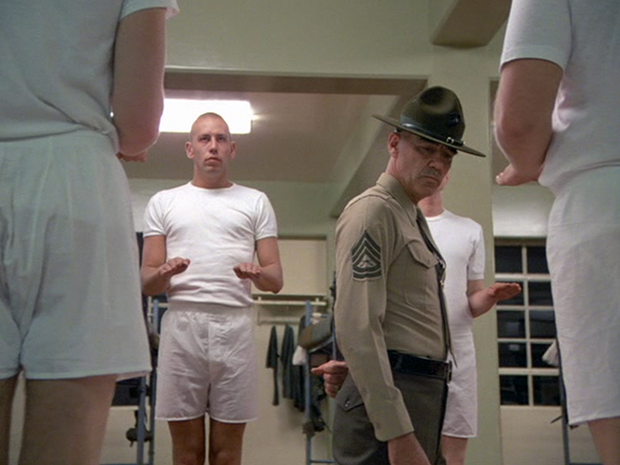 118 |
 119 |
|
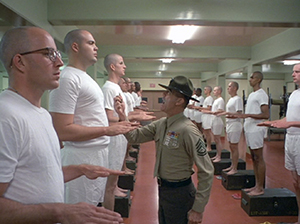 120 |
 121 |
|
 122 |
 123 |
|
 124 |
 125 |
|
 126 |
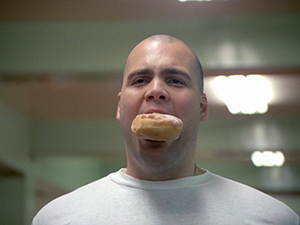 127 |
|
 128 |
||
There is no jelly doughnut scene in the book. There is no unlocked locker. Instead, when the recruits near graduation day, they begin to sneak sugary snacks from the mess hall and it's considered as a sign that they're without fear, well on their way to being warrior killers.
We spread butter on slices of bread and then sprinkle sugar on the butter. We smuggle sandwiches out of the mess hall, risking a beating for the novelty of unscheduled chow. We don't give a shit; we're salty. Now, when Sergeant Gerheim and his junior drill instructors stomp us we tell them that we love it and to do it some more. When Sergeant Gerheim commands: "Okay, ladies, give me fifty squat-thrusts. And some side-straddle hops. Many, many of them," we laugh and then do them.
The drill instructors are proud to see that we are growing beyond their control. The Marine Corps does not want robots. The Marine Corps wants killers. The Marine Corps wants to build indestructible men, men without fear. Civilians may choose to submit or to fight back. The drill instructors leave recruits no choice. Marines fight back or they do not survive. There it is. No slack.
Pyle has taken the same risk, but he's not a warrior killer yet though he has come around and performs well. In the book, Joker's training of him isn't repaid with such a good response, Pyle doesn't improve, he only continues to screw up.
Pyle's locker is found to be unlocked and thus it's revealed he's hidden a jelly doughnut. Pyle has no problem admitting that he took the doughnut. If he has no problem admitting to the doughnut, it seems he would also readily admit that he carelessly left his locker unlocked. He doesn't. So we've a mystery. How did his locker become unlocked? If Pyle didn't do it, who did? And why? To sabotage Pyle? To sabotage not only Pyle but Joker's retraining of Pyle in his patient manner? One might be reminded of The Shining and the mystery of how Jack got out of the locked pantry in the kitchen. The audience is tasked with wondering if it was Danny who opened the storage room while Wendy was sleeping, or did Wendy not secure the lock though it appeared she had, or was it the Overlook itself that opened the door, the caretaker spirit of which has been urging Jack to punish Danny for his disobedience. Kubrick sets up the same mystery here, so we wonder who had Pyle's lock combination and opened it. Could it have been Hartman, teaching everyone a lesson about helping Pyle, that the soft way isn't the right way? Could it have been Joker, not wanting to be a squad leader, resenting his having to help Pyle? Could it have possibly been Cowboy, resenting Pyle's bonding with Joker and the fact he and Joker no longer share the same rack? One of these may be the case, but Kubrick has not only left the lock unlocked, he has it flipped, reversed, and in Kubrick's films this is of significance.
It's tough to find what's missing if you don't know exactly what to look for. We think Hartman is saying that Pyle, with his unlocked footlocker, is making it easy for people to steal from him, creating thieves, but when he opens the locker to see what's missing, we realize the situation has flipped and instead it's Pyle who is the thief and what was missing was a jelly doughnut from the mess hall that he'd taken. This would seem to indicate that Hartman somehow knew that Pyle had taken the doughnut and he knew where Pyle had put it. As the D.I. he certainly knew the combination to Pyle's lock as this information is recorded by the D.I.
The screenplay has the doughnut scene, but doesn't have the unlocked locker. Instead, the D.I. shows the doughnut to Pyle and asks him if he knows where he found it, Pyle confessing it would have been in his locker.
Another Kubrick film in which there was a lock scene was A Clockwork Orange, Alex protecting the privacy of his room with a combination lock.
Another instance of something missing in a Kubrick film was Bill's rented mask, in Eyes Wide Shut, which he had locked in a cabinet in his home office yet disappeared. There is some internal logic in the film as to the how of the mask's disappearance but otherwise the film maintained the question over how it escaped the cabinet only to appear on Bill's pillow, resulting in his breaking down and telling Alice about his visit to Somerton.
129 Crossfade to MS of Joker helping Pyle dress. He buttons Pyle's shirt front and pockets, and fixes his collar. (26:34)
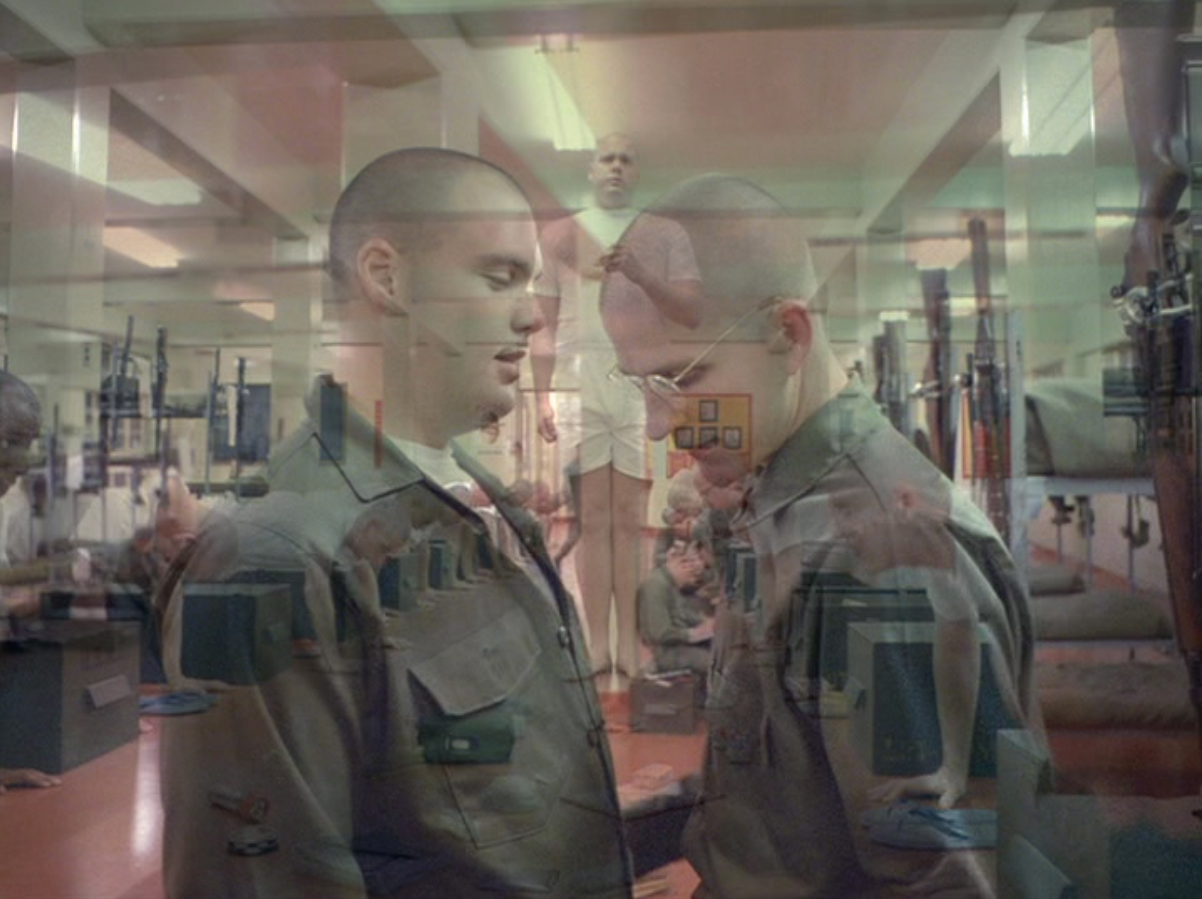
JOKER: You really look like shit today, Leonard.
PYLE (seeking a connection with Joker's eyes, Joker reluctant to look at him): Joker, everybody hates me now. Even you.
JOKER: Nobody hates you, Leonard. You just keep making mistakes, getting everybody in trouble.
PYLE: I can't do anything right. I need help.
JOKER: I'm trying to help you, Leonard. I'm really trying. Tuck your shirt in.
130 Exterior shot of the platoon performing repetitive plank poses, the camera tracking past to show Pyle seated sucking his thumb. (27:38)
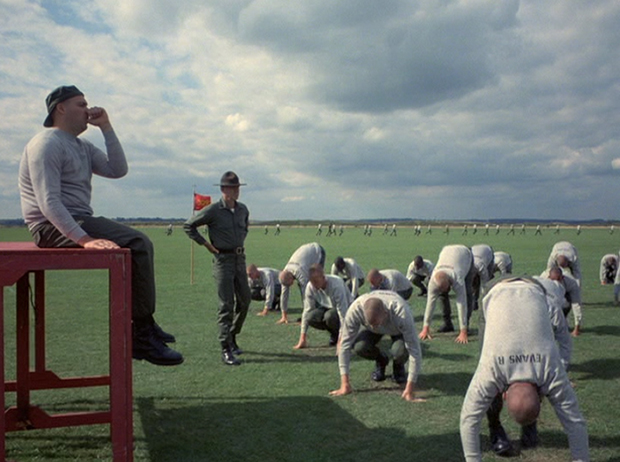
RECRUITS: One, two, three, 19. One, two, three, 20. One, two, three, 21. One, two, three, 22. One, two, three, 23. One, two, three, 24. One, two, three, 25. One, two, three, 26. One, two, three, 27. One, two, three, 28. One, two, three, 29. One, two, three, 30.
131 Night. CU of a towel being laid out on a bed and a bar of soap placed in the center and wrapped up. We see the letters U.S. at the top of the blanket. The "Leonard" soundtrack begins. The person who has wrapped up the soap with the towel pounds it twice on the bed. (28:02)
132 MCU of Joker on his rack, supposedly hearing the pounding. He gets out and looks at Pyle asleep above him. (28:17)
133 MCU of Cowboy in his rack. (28:43)
134 MS of Cowboy and others climbing out of their racks, Cowboy taking out from under his pillow the cloth that will be used to gag Pyle. (28:49)
They quietly cross the room to Pyle and Joker's bunk. Joker stands there holding the soap wrapped in the towel. They bind Pyle's blanket over him, and Cowboy gags him. The recruits begin to hit him with their bars of soap, each person landing two blows.
135 MS of Cowboy continuing to hold down Pyle and Joker watching. (29:15) Finally it's Joker's turn.
COWBOY (to Joker): Do it. Do it.
At Cowboy's urging he hits Pyle, his rage such that he hits him six times. The other recruits flee back to their beds.
COWBOY (after he releases Pyle): Remember, it's just a bad dream, fat-boy.
136 MCU of Joker covering his ears so as not to hear Pyle's cries. Fade to black. (29:59)
 131 |
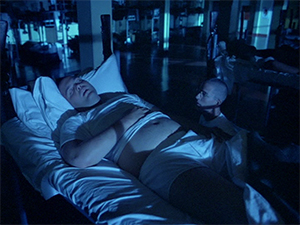 132 |
 133 |
 134 |
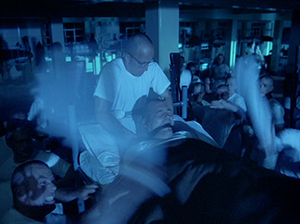 135 |
 136 |
With the jelly doughnut incident, in the film, Pyle regresses so dramatically that Joker has to dress him. In shot 130, he is once again reduced to sucking his thumb, as in shot 60, but this time Pyle rests as he does so while the group exercises for whatever was his most recent failure. A conversation is included from the book, the situation in the novel having been that Pyle didn't improve under Joker.
I'm repulsed by the look and feel of my own weapon. The rifle is cold and heavy in my hands. "Think of your rifle as a tool, Leonard. Like an ax on the farm."
Leonard grins. "Okay. You right, Joker." He looks at me. "I'm sure glad you're helping me, Joker. You're my friend. I know I'm slow. I always been slow. Nobody ever helped me..."
I turn away. "That sounds like a personal problem," I say. I keep my eyes on my weapon.
This conversation, in the novel, follows after Joker's insistence he doesn't want to be squad leader. There is one other time in the novel that Joker responds, "That sounds like a personal problem", which is when Cowboy becomes squad leader in Vietnam, during the Battle of Hue, and tells Joker his reluctance to send out his men to find the sniper, worried that they'll be killed. Cowboy is unable to make a decision, hoping for support from Joker, and Joker responds, "That sounds like a personal problem", but does voice how he will support Cowboy. However, when Cowboy makes the decision to find the sniper, and turns away the assistance of a tank, with Animal Mother's approval, Joker steps in and mildly suggests to Cowboy how and why tank support should be used. This is the right decision, but we understand that Joker is fearful of making any kind of commitment that could possibly result in his being turned to as an authority figure.
Does Joker hate Pyle? If nothing else he is so frustrated by Pyle's regression that he can't meet his gaze when Pyle asks how he feels about him. Pyle's failures are taken out on the whole group by Hartman, and as Pyle becomes thus a hardship for everyone, sympathy for Pyle is exhausted.
Kubrick drops in another mystery at the beginning of the "Bad Dream" scene, showing the disembodied hands of an individual wrapping up a bar of soap in a towel and pounding the bed with it, which we'll soon realize is in preparation for the assault on Pyle. One might assume it is Cowboy or Joker, but Cowboy doesn't beat Pyle, he is the one who keeps him gagged throughout, and after we are shown the wrapping up of the soap we see Joker resting on his bunk without the soap, waiting. It may be the reason for the disembodied hands is that this is a group action of retribution, which is what Hartman has wanted, to solidify the recruits as a group. This bonding of the Marines is important, and boot camp's obstacle course presents situations that can only be solved as a group, which isn't shown in the film. Pyle becomes the enemy of all, due Hartman punishing everyone rather than just Pyle, so Pyle becomes the center for their bonding. Pyle is an obstacle that they band together finally to force into line so he is no longer just Joker's responsibility.
Sergeant Gerheim's imagination is both cruel and comprehensive, but nothing works. Leonard continues to fuck up. Now, whenever Leonard makes a mistake, Sergeant Gerheim does not punish Leonard. He punishes the whole platoon. He excludes Leonard from the punishment. While Leonard rests, we do squat-thrusts and side-straddle hops, many, many of them.
Leonard touches my arm as we move through the chow line with our metal trays. "I just can't do nothing right. I need some help. I don't want you boys to be in trouble. I--"
I move away.
The first night of our seventh week of training the platoon gives Leonard a blanket party.
Midnight.
The fire watch stands by. Private Philips, the House Mouse, Sergeant Gerheim's "go-fer," pads barefoot down the squad bay to watch for Sergeant Gerheim.
In the dark, one hundred recruits walk to Leonard's rack.
Leonard is grinning, even in his sleep.
The squad leaders hold towels and bars of soap.
Four recruits throw a blanket over Leonard. They grip the corners of the blanket so that Leonard can't sit up and so that his screams will be muffled.
I hear the hard breathing of a hundred sweating bodies and I hear the fump and thud as Cowboy and Private Barnard beat Leonard with bars of soap slung in towels.
Leonard's screams are like the braying of a sick mule, heard far away. He struggles.
The eyes of the platoon are on me. Eyes are aimed at me in the dark, eyes like rubies.
Leonard stops screaming.
I hesitate. The eyes are on me. I step back.
Cowboy punches me in the chest with his towel and a bar of soap.
I sling the towel, drop in the soap, and then I beat Leonard, who has stopped moving. He lies in silence, stunned, gagging for air. I beat him harder and harder and when I feel tears being flung from my eyes, I beat him harder for it. The next day, on the parade deck, Leonard does not grin.
Joker is also a focal point of the Bad Dream assault, for it is important that he become involved and a part of the group by taking part in assaulting Pyle. This is emphasized in the book by Cowboy pounding Joker once in the chest with his bar of soap, which is what it takes for Joker to take part. Whereas everyone else hits Pyle once, his anger given opportunity for expression, Joker hits Pyle six times. But his guilt is such that afterward he must cover his ears against Pyle's cries of anguish.
Tribes' version of this instead offers expression for the group's rage at their D.I.
Adrian, furious with the D.I. over his treatment of a recruit who had slashed his wrists, finally loses his cool composure and pounds his bed with a pillow. The rest of the men begin beating their beds with their pillows as well, which turns into a pillow fight. This is a very different situation but the scene is much the same as in Full Metal Jacket with blurs of white assailing the dark.
Cowboy's admonishment for Pyle to "remember, it's just a bad dream" isn't in the book or the screenplay. One might see it as anticipating the confusion between dream and really in Eyes Wide Shut, Bill listening with uncertain confusion as Alice told him her dream, and the film ending with Alice stating she is grateful they have survived through all their adventures whether they were real or just a dream, and Bill adding that no dream is ever just a dream.
In the case of Pyle, Cowboy's warning puts Pyle in the position of having to behave as though this reprisal was the product of his own unconscious, which is not too far removed from Hartman originally having forced Pyle to choke himself on Hartman's hand. Reality is denied.Pyle is made responsible for the severest abuses he's suffered. He's perpetrated them on himself. Kubrick certainly must intend us to link this back also to Jack's nightmare in The Shining, immediately after which, as Wendy attempts to soothe him, even as he relates he had dreamed he had killed her and Danny, Danny enters with the choke marks on his neck, sucking his thumb, speechless, just as Pyle will now be rendered mute.
I wanted to note that with the counting off the drop-planks the soldiers perform in shot 130 reminded me of Lolita counting off her hula-hoop twirls while Charlotte snuck in and took a photo of Humbert, which wasn't in the book. In shot 95, Lolita counts from 31 to 53, stopping at 54 as Charlotte takes her surprise photo. Here we have the count being from 19 to 30. It's as if Lolita picks up at 31. The only reason I note this is because of that shot in Lolita connecting with Day of the Fight. As I note in that analysis:
{Shot 64 in Lolita is a transitional shot, informing only "4 years earlier", and takes us back to Humbert's arrival in the States. These notes are on that shot.)
Kubrick was a chess player and so I pay attention with shot 64 being the demarcation that moves us from the present to the past. in Day of the Fight in the original production Kubrick had the boxer, Walter Cartier, approach the boxing ring in shot 64, and had anticipated this in shot 30 with the statement, "It's 4. 6 hours before he enters the ring." In the 2nd, Bonafield Production, as an intro was added, it threw off the numbering of the shots, so it seems that the young Kubrick, to preserve the use of 64 in the original cut, edited the introduction so it was composed of 64 shots. That placed what was shot 30 in the original production at shot 94. If we go to shot 94 in Lolita we happen to have the first shot of the one section in which Charlotte and Humbert play chess, and as it happens that is the only shot in that section, so the entire segment devoted to the chess game is fulfilled in that single shot, 94. Beautiful! Now, how can we be confident that Kubrick is referring to shot 30 in Day of the Fight which became shot 94 due the 64 shots added in the introduction? Because in shot 95, in Lolita, Kubrick has Lolita counting off her number of twirls of a hula-hoop, and Kubrick has her begin with the number 31.
I don't see anything resembling that kind of number play here, but I'm inclined to think I just don't see it and that it's present. The only thing I see is that Pyle's locker is discovered to be unlocked in shot 119 (the count of the men's drop-planks starts at 19) and that 11 shots transpire between 119 and 130, which is the number of drop-planks the men perform perform in 130.
137 Exterior. Day. The platoon stands at attention. (30:14)

HARTMAN: Port.Hut! Left shoulder. Hut! Right shoulder. Hut! Port. Hut!
Do we love our beloved Corps, ladies?
RECRUITS:
Semper Fie, do or die. Gung ho. Gung ho. Gung ho.
HARTMAN: What makes the grass grow?
138 MCU on Pyle who is silent, expressionless, zooming in on him. (30:46)

RECRUITS: Blood, blood, blood.
HARTMAN: What do we do for a living, ladies?
RECRUITS:
Kill, kill, kill.
HARTMAN: I can't hear you.
RECRUITS:
Kill, kill, kill.
HARTMAN: Bullshit. I still can't hear you.
RECRUITS:
Kill, kill, kill.
139 Crossfade to MLS of Hartman facing the recruits who are seated on bleachers. (31:01)
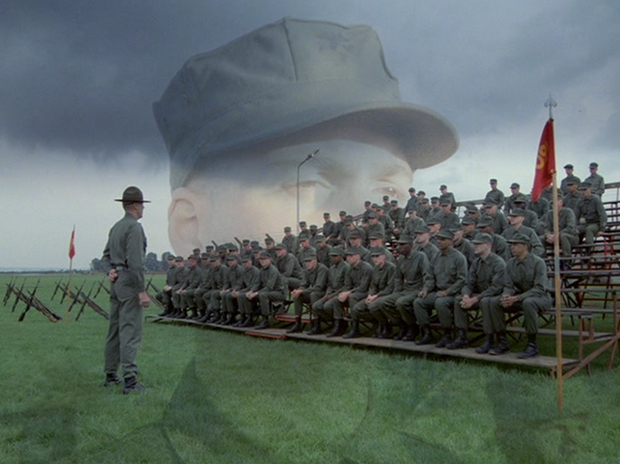
HARTMAN: Do any of you people know who Charles Whitman was? None of you dumb-asses knows? Private Cowboy.
140 MCU on Cowboy, the only one who raised his hand, as he stands and responds. (31:11)
COWBOY: Sir, he was that guy who shot all those people from that tower in Austin, Texas, sir.
141 MCU of Hartman. (31:16)
HARTMAN: That's affirmative. Charles Whitman killed 12 people, from a 28-story observation tower at the University of Texas, from distances of up to 400 yards.
142 MLS of Hartman facing the recruits as in 136. (31:25)
HARTMAN: Anybody know who Lee Harvey Oswald was? (Many people raise their hands.) Private Snowball.
143 MCU on Snowball as he stands and responds. (31:30)
SNOWBALL: Sir, he shot Kennedy, sir.
144 MCU on Hartman. (31:33)
HARTMAN: That's right. And do you know how far away he was?
145 MCU on Cowboy as he responds. (31:36)
SNOWBALL: Sir, he was pretty far. From that book-suppository building, sir.
The recruits laugh.
146 MLS on Hartman before the recruits as in 139. (31:40)
HARTMAN: All right, knock it off. Two-hundred-and-fifty feet.
147 MCU on Hartman. (31:44)
HARTMAN: He was two-hundred-and-fifty feet away and shooting at a moving target. Oswald got off three rounds with an old Italian bolt-action rifle in only six seconds and scored two hits, including a head shot. Do any of you people know where these...
148 MCU on Joker who raises his hand. (31:58)
HARTMAN: ... individuals learned how to shoot?
Private Joker.
JOKER: Sir, in the Marines, sir.
149 MCU on Hartman. (32:05)
HARTMAN: In the Marines. Outstanding. Those individuals...
150 MCU zoom in on Pyle in his "Kubrick" stare mode. (32"09")
HARTMAN: ...showed what one motivated Marine and his rifle can do, and before you ladies leave my island, you will all be able to do the same thing.
 140 |
 141 |
|
 142 |
 143 |
|
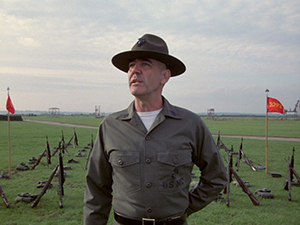 144 |
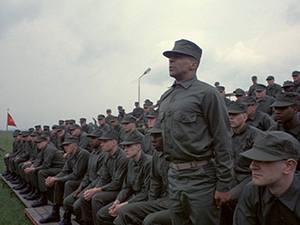 145 |
|
 146 |
 147 |
|
 148 |
 149 |
|
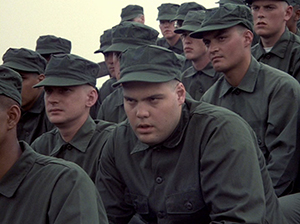 150 |
||
From the book:
The next day, on the parade deck, Leonard does not grin.
When Gunnery Sergeant Gerheim asks, "What do we do for a living, ladies?" and we reply, "KILL! KILL! KILL!," Leonard remains silent. When our junior drill instructor asks, "Do we love the Crotch, ladies? Do we love our beloved Corps?" and the platoon responds with one voice, "GUNG HO! GUNG HO! GUNG HO!." Leonard is silent.
"Gung ho" became a motto of the Marine Corps through a Major Evans Carlson, having learned it from a New Zealand friend, Rewi Alley, one of the founders of the Chinese Industrial Cooperatives. Wikipedia relates a 1943 interview with Carlson: "I was trying to build up the same sort of working spirit I had seen in China where all the soldiers dedicated themselves to one idea and worked together to put that idea over. I told the boys about it again and again. I told them of the motto of the Chinese Cooperatives, Gung Ho. It means Work Together — Work in Harmony."
The other recruits may have bonded in uniting against Pyle, but Pyle now has no one, and has been especially betrayed by his rack mate, Joker.
And Hartman, who would usually be diving down the throat of a recruit to drag out of him a response, and a louder response if his response wasn't loud enough, ignores Pyle's silence, that he is not "gung ho" participating, part of the group, utterly alienated. The book addresses Hartman's denial in this regard, which is important and I approach in the "Happy Birthday" section notes.
From the book:
On the third day of our seventh week we move to the rifle range and shoot holes in paper targets. Sergeant Gerheim brags about the marksmanship of ex-Marines Charles Whitman and Lee Harvey Oswald.
Hartman expresses to his recruits that, ultimately, pride can be had in the Marine who successfully, displaying remarkable skill, turns his training on civilians (and his family, Whitman killed his mother and wife before going to the tower). Pride can even be had in the Marine who successfully, displaying remarkable skill, turns his training on the president of the United States. The "brotherhood" of the Marines is thus one in which all others are so estranged as to be the enemy. In this lesson, it doesn't matter who was killed, but that it was done with a precision and hard heart determination mastered in the Marine Corps.
Snowball accidentally says that Oswald shot from the book "suppository" building and the recruits laugh at him for this, but Hartman erroneously states that Whitman killed twelve people and his error isn't noted. Instead, Whitman killed fourteen people from the tower. Both of these errors are in the screenplay. They aren't in the book, but this scene in the novel only amounts to a couple of sentences and has no specifics. It is greatly expanded in the screenplay. Hasford entered the Marines within four or so months after Whitman's assault from the tower on August 1, 1966, and one has to wonder if his D.I. had similarly enthused over Whitman and Oswald. I'll address these errors further in the "Happy Birthday" section.
When this film came out, I didn't like it, and the reason I didn't like it had nothing to do with its being a war film. It had to do with what later became known as the "Kubrick Stare", the glare of Jack's in The Shining that is so obviously resurrected in Full Metal Jacket. If there had been less emphatic versions of it in earlier films, the stare didn't constellate as a "thing" until Full Metal Jacket, when Pyle, quickly coasting into derangement, stares out from under that severe overhang of a brow and smiles what is in the book described as a werewolf smile. No one was calling it the "Kubrick Stare" yet, but as I sat in the theater and watched the film, and saw Pyle burdened with Jack's expressions, I thought, oh, come on, and what I felt was peeved with the artistic choice Kubrick had made in doing this. For me, I felt it was damaging to the integrity of The Shining and Full Metal Jacket to risk making characters into caricature by virtue of dragging this stare over from Jack and plopping it on Pyle. As it turns out, Kubrick, in respect of the majority of the audience, may have made the right decision, for it seems people enjoy the idea of the "Kubrick stare" and now like to identify it in other works as referencing Kubrick. But, I felt the character of Pyle should have stood on its own, and that Jack should have stayed in The Shining instead of reappearing.
Jack had apparently (certainly) frozen to death at the end of The Shining, then had reappeared in an old photo of the Overlook, then there came the ghostly remnants of the first ending of The Shining, in which it was told Wendy in the hospital that Jack had disappeared. I eventually considered if this was part of Kubrick's artistic vision, that whatever embodies Jack's stare should be less personal than as a Japanese mask that identifies a particular demon. And Joker does tell Pyle, in the novel, that he should think of his rifle like a tool, "like an ax on a farm." I can see how this would have struck Kubrick as a call to the insanity that occupied Jack. In a way, I've only been able to accept it as an acceptable artistic choice, resurrecting Jack in Pyle, if I consider Kubrick needed to have Jack's derangement be undeniably resurrected in Pyle for its nature to be understood. It's obvious in The Shining that Jack is essentially possessed by the imperialist mindset that created America and The Overlook, the reality of which was always suppressed, and in all his war films Kubrick has been concerned with the same sacrifice of all to elite power games. Jack had no power. As a caretaker, he was merely upholding a status quo which only benefited him by conferring on him the approval of a father for a son who doesn't question authority. The same is demanded in the Marines, the recruits being more Isaacs who are willingly laid out on the altar for sacrifice by Abraham, a subject that Kubrick explored in The Shining. Those who are prepared to accept their sacrifice, must then demand the sacrifice of others, and so it goes from generation to generation.
151 MCU on Hartman as he strides through double lines of the recruits in the squad bay, all singing "Happy Birthday". (32:19)
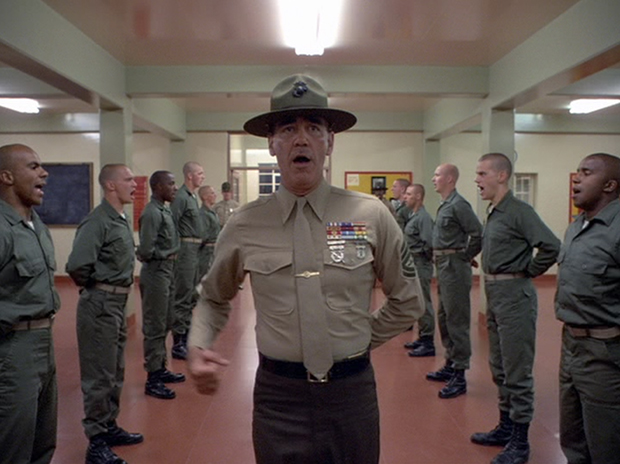
HARTMAN: Today is Christmas. There will be a magic show at zero-nine-thirty.
He turns to go in the opposite direction.
152 MCU Hartman walking the opposite direction away from the exit. (32:50)
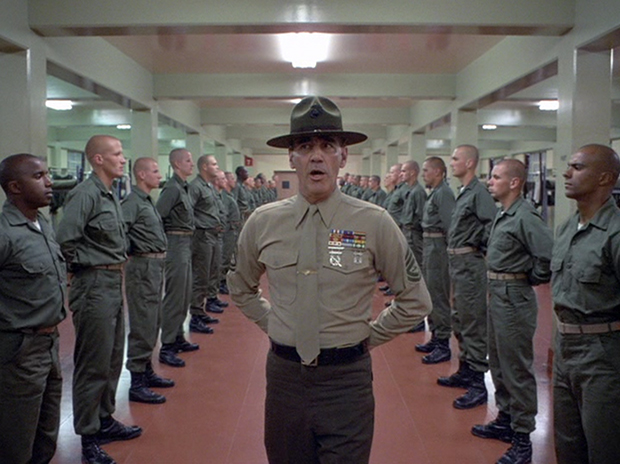
From the exit, on the starboard side, Cowboy appears to be 12th, Pyle 13th, and Joker 14th.
HARTMAN: Chaplain Charlie will tell you about how the free world will conquer communism with the aid of God and a few Marines. God has a hard-on for Marines because we kill everything we see. He plays his games, we play ours. To show our appreciation for so much power, we keep heaven packed with fresh souls.
He turns to go in the opposite direction.
153 MCU Hartman walking the opposite direction. (33:31)
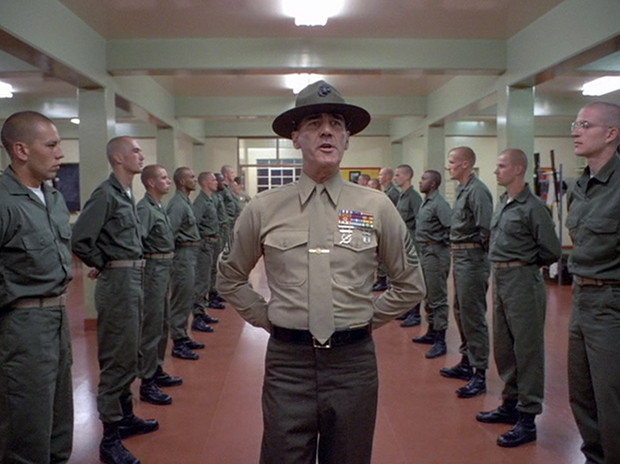
Joker is the 8th individual from the office/head area, Pyle the 9th, and Joker the 10th.
HARTMAN:
God was here before the Marine Corps. So you can give your heart to Jesus but your ass belongs to the Corps. Do you ladies understand?
RECRUITS:
Sir, yes, sir.
HARTMAN: I can't hear you.
RECRUITS:
Sir, yes, sir.
154 MS Hartman passes from the bunks to the deck through the line of port recruits cleaning their rifles. On the starboard side, Pyle is in the forefront, speaking as he cleans his rifle. Hartman turns and walks in the opposite direction away from him. (33:51)
PYLE: It's been swabbed and brushed. Everything is clean. Beautiful. So that it slides perfect. Nice.
155 MCU Joker watching Pyle. (34:17)
PYLE (off screen): Everything Clean. Oiled.
156 CU of Pyle's profile. (34:24)
HARTMAN: So that your action is beautiful. Smooth Charlene.
157 MCU of Joker watching Pyle as in shot 155. (34:34)
 154 |
 155 |
 156 |
 157 |
158 Crossfade to Pyle in the foreground as he and several other recruits swab the floor of the squad bay, Hartman watching. (34:39)
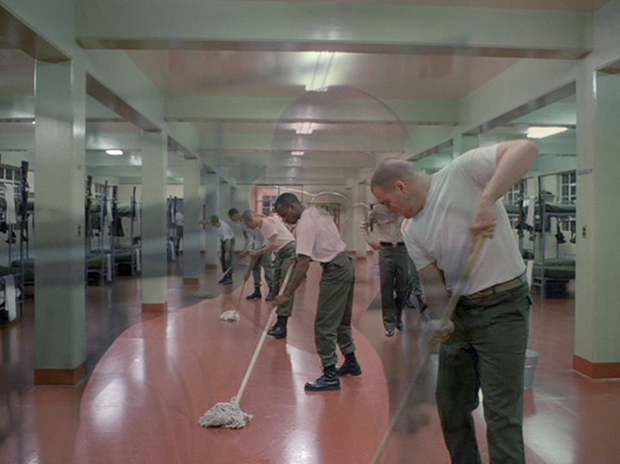
159 MS of Cowboy and Joker swabbing the head. (34:45)

JOKER: Leonard talks to his rifle.
COWBOY (who has been swabbing around the toilet where we will observe Pyle dead in shot 214): Yeah.
JOKER: I don't think Leonard can hack it anymore. I think Leonard's a Section Eight.
COWBOY: It don't surprise me.
JOKER: I wanna slip my tube steak into your sister.
What will you take in trade?
COWBOY:
What do you got?
160 MS of Pyle on the range, shooting at a target as Pyle stands behind and watches..He fires 4 shots. (35:46)
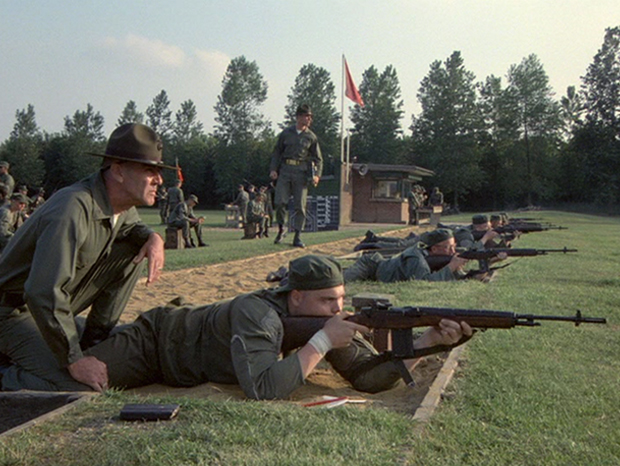
161 Extreme long shot over Pyle's shoulder of the target far in the distance. He is firing on the 7 through 11 bank. Three more shots. (35:52)
162 MS of Pyle and Hartman as in 160. He fires 2 shots. (35:57)
Pyle wears a bandage on his right wrist in shots 160 and 162. It is on his left wrist in shot 161.
HARTMAN: Outstanding, Private Pyle. I think we finally found something that you do well.
PYLE (reloading): Sir, yes, sir.
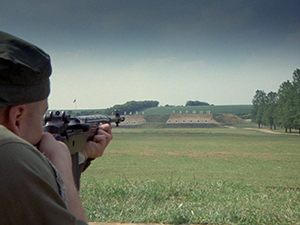 161 |
 162 |
163 MS profile of Hartman facing Joker who is with the rest of the recruits on the parade tarmac. (36:08)
HARTMAN: What's your sixth general order?
JOKER:
Sir, the sixth general order is to receive and obey and pass on to the sentry who relieves me all orders... Sir, the private's sixth general...the private has been instructed but does not know.
HARTMAN: You slimy scumbag, get on your face and give me twenty-five.
JOKER: Sir, aye, aye, sir.
HARTMAN (passing down the line past Cowboy and another recruit to Pyle and receiving his rifle): How many counts in that movement you just executed?
164 MCU of Pyle from behind Hartman's shoulder. (36:08)
PYLE: Sir, four counts, sir. 163 164
165 MS of Hartman running with the recruits. (37:02)
HARTMAN:
I don't want no teenage queen
166 Crossfade to the recruits hiking down a path in the woods. (37:41)
JOKER: Graduation is only a few days away, and the recruits of Platoon thirty-ninety-two are salty. They are ready to eat their own guts and ask for seconds. The drill instructors are proud to see that we are growing beyond their control.
167 Crossfade to the troops running through a grassy area toward the camera, yelling their batte cry. (38:00) JOKER: The Marine Corps does not want robots. The Marine Corps wants killers.
The Marine Corps wants to build indestructible men. Men without fear. 165 166 167 Kubrick typically times his films so that at least a part of them occurs in the winter holiday season, or decorations from the winter holiday season are displayed. Killer's Kiss shows a Christmas decoration though the action occurs in October. The Killing shows Christmas decorations hanging on the street, though the action occurs in late October to early November. Action in The Shining begins some time before the hotel's season shuts down at the end of October , and continues to some time after Thanksgiving. Eyes Wide Shut takes place before Christmas. Again, Kubrick has Christmas celebrated in Full Metal Jacket but it's not mentioned in the book. A change made in the film from the book is that Hartman states, "God was here before the Marine Corps. So you can give your heart to Jesus but your ass belongs to the Corps. Do you ladies understand?" Instead, in the book and screenplay it's said that the Marine Corps was "here" before God.
In Vietnam, Crazy Earl is the individual who tells Joker he's celebrating the birthday of the dead Viet Cong he has positioned to sit next to him. Then Crazy Earl is killed by picking up a large booby-trapped rabbit toy that wears a top hat and jacket similar to that of a magician. So the rabbit seems to refer back to the Happy Birthday sections. I pay attention to certain types of errors in Kubrick's films because of HAL, and because of his first feature film, Fear and Desire, in which the character of Sidney is permitted to make a very glaring error in his relation of a scene from The Tempest.
Certain errors in Kubrick can be understood as asking the audience to pay critical attention and consider the meaning of the error. In Fear and Desire, we may find its origin in a chess game at the end of Shakespeare's play, and anticipates HAL's malfunction in 2001. In The Killing , Kubrick seems to even highlight an error in continuity in the book, and we eventually have the character of Johnny making a peculiar error when he attempts to open a wrong door at the cabin motel after the race track heist is pulled. The same type of error occurs in Eyes Wide Shut, when Bill return's to Domino's apartment, and similarly has a moment of confusion over two doors until, as in The Killing, he hears voices from within and realizes he was approaching the wrong one and adjusts his choice. A new scene was written for the film in which was embedded the conversation on Pyle's naming of his rifle. Charlene. One might wonder if it was the feminine version of "Charlie", slang for Viet Cong shortened to VC, which in military alphabet code was Victor Charlie, then was further shortened to Charlie. But Gustav Haford's wife's name was Charlene as well. In the novel, when Joker voices that Pyle is talking to his rifle, others are freaked out because of similar experiences, they confess they are starting to have dialogue with their rifles in their dreams--which isn't surprising with such intensive training. Indeed, the Corps drills it into the solder that they live to die for the Marine Corps. In Tribes, Quentin, who was the one with left-right confusion, is one night found by Adrian in the head with his wrists slashed. The D.I. responds in the same manner as the D.I. in The Short-timers, giving a lecture to the recruits on the appropriate way of slashing one's wrists, which is when Adrian, who has managed to remain largely unfazed by the strain of boot camp, releases his rage by furiously beating his bed with his pillow. Having been the one to find Quentin, and urgently tried to get help for him, he's appropriately confused by the D.I.'s reaction and even himself traumatized by the incident. The attempted suicides of Quentin and Perkins seem to be have been absorbed into the Pyle character in Full Metal Jacket.
168 The squad bay. MCU of Hartman with 2 assistant DIs in the background. We rarely are able to read the time and we observe a clock that reads 5:10. Continue with the Marine Corps hymn. (38:00) HARTMAN: Today, you people are no longer maggots.
169 MS of Hartman from the rear with the platoon in a semi-circle before him, men in the rear standing and some in the front standing. Pyle is seated center, staring vacantly. Joker and Cowboy are on the extreme right, standing. (38:21) HARTMAN: Today, you are Marines. 170 LS of the parade grounds from high in the viewing bleachers. This is real graduation footage from Parris Island. We view, from the rear, a woman in a beige suit standing, taking a photo of the parade, which I would think is one reason why this bit of footage is used. (38:27) HARTMAN (voice-over): You're part of a brotherhood. From now on, until the day you die... 171 LS of the parade grounds from high in the viewing bleachers, real graduation footage from Parris Island. This footage shows the heads of the crowd, from the rear. In the foreground are several Black individuals, which may be a reason why this footage is used, emphasizing the integrated crowd and platoon. (38:35) HARTMAN (voice-over):
...wherever you are, every Marine is your brother. 172 MLS of Joker's platoon, #3092, on the parade grounds, facing right (screen left) as they march. Pyle, Joker, and Cowboy are in the foreground. They face front. As they parade, Joker, Cowboy and Hartman fill the frame, then Joker and Cowboy. Begin crossface back to the squad bay. (38:40) HARTMAN (voice-over):
Most of you will go to Vietnam. Some of you will not come back, but always remember this: Marines die.
That's what we're here for. But the Marine Corps lives forever and that means you live forever. 173 MS as of 169, of Hartman with the men seated and standing in a semi-circle in the squad bay. Fade out Marine Corps Hymn. (39:08) HARTMAN:
Pickett. 174 MS of Hartman, 3/4 view from the right with men seated and standing behind him. (39:17) HARTMAN:
Adams. The situation of individuals is slightly different from the shot that shows the whole platoon. In these shots that split the platoon, Adams is seated 2nd from screen left and doesn't have anyone crouching/seated behind him. 175 MS of Cowboy, 3/4 view from the right with men seated and standing beyond him. (39:23)
COWBOY: Sir, yes, sir. 176 Hartman, as of 174. (39:26)
HARTMAN: Taylor. 177 Joker. Shot as of 175. (39:30)
JOKER: Sir, yes, sir. 178 Hartman, as of 176, (39:32)
HARTMAN:
Basic Military Journalism. You gotta be shitting me, Joker. You think you're Mickey Spillane? You think you're some kind of fucking writer? 179 CU of Joker, directly to the camera. (39:40)
JOKER: Sir, I wrote for my high-school newspaper, sir. 180 Hartman, as of 178. (39:41)
HARTMAN: Jesus H. Christ. You're not a writer, you're a killer. 181 CU of Joker, as of 179. (39:45)
JOKER: A killer, yes, sir. 182 CU of Pyle, staring vacantly into the camera. (39:47)
HARTMAN (off screen): Gomer Pyle. Gomer Pyle. 173 174 175 176 177 178 179 180 181 182 There are, it seems, only two location shots of Parris Island in the film, being shots 170 and 171 from graduation day. For some reason, Kubrick has chosen shots from two different parades. Each shot shows the parade ground from the bleachers, and leading from the bleachers to the parade ground is a walkway marked off with ropes. In the first shot, the right red pole closest the parade is tipped with white, as is the one opposite it. There are no flags observed. In the next shot, the poles that had the white tips are instead entirely red and there is a flag pole before each bearing a red Marine Corps flag. I don't seem to see a U.S. flag on display in 171, which was observed in 170. The film uses the real platoon # of Gustav Hasford, who graduated from Parris Island in November of 1966. His Drill Sgt. was an individual named Kurtz. This knowledge, including praise of Kurtz, was put online by an individual who had Kurtz as his D.I. before Hasford, and states he's aware that the doughnut incident was based on Kurtz having caught a friend of Hasford's stealing a couple of doughnuts from his quarters (source). A person commented they had the same D.I. (appeared to have been also in 3092) and that he remembered abuse--a recruit who tried to escape twice and after the second time showed up with his jaws wired together, which was said to have happened because he fainted on concrete, and how after he himself had dropped his rifle in the rain the D.I. had slipped his hand under his poncho and up to his throat, and applied "pressure" while questioning him. Another person commented and said Kurtz was the "toughest" D.I. instructor.
HARTMAN: What's the idea of looking in the chamber?
PYLE: Sir, to guarantee the private is not giving the inspecting officer a loaded weapon, sir.
HARTMAN: What's your fifth general order?
PYLE: Sir, the fifth general order is to quit my post only when properly relieved, sir.
HARTMAN: What's this weapon's name, Private Pyle?
PYLE: Sir, the private's weapon's name is Charlene, sir.
HARTMAN: Private Pyle, you are definitely born-again hard. Hell, I may even allow you to serve as a rifleman in my beloved Corps.
PYLE: Sir, yes, sir.


RECRUITS:
I don't want no teenage queen
HARTMAN: I just want my M14
RECRUITS: I just want my M14
HARTMAN:
If I die in a combat zone
RECRUITS:
If I die in a combat zone
HARTMAN:
Box me up and ship me home
RECRUITS:
Box me up and ship me home
HARTMAN:
Pin my medals upon my chest
RECRUITS:
Pin my medals upon my chest
HARTMAN:
Tell my mom I done my best
RECRUITS:
Tell my mom I done my best
Begin "The Marines' Hymn" faintly in the background.
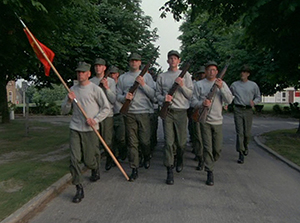
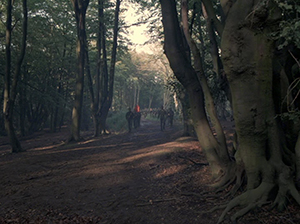

NOTES
HAPPY BIRTHDAY
Sunday.
Magic show. Religious services in the faith of your choice--and you will have a choice--because religious services are specified in the beautiful full-color brochures the Crotch distributes to Mom and Dad back in hometown America, even though Sergeant Gerheim assures us that the Marine Corps was here before God. "You can give your heart to Jesus but your ass belongs to the Corps."THE ERRORS OF HARTMAN AND JOKER / THE MARINE CORPS DOES NOT WANT ROBOTS, IT WANTS KILERS
In the rifle training scene in which Hartman praises Oswald and Whitman's skills, Snowball makes an error in speech and this is noticed by the recruits and Hartman calls for them to stop their ridiculing him for it. What the audience probably doesn't notice is that Hartman errs in his recounting how many people Whitman killed from the tower. Neither of these errors was in the book, and we are only going to have Snowball's error as a way of pointing to Hartman's which slides by and is not pointed out to the audience.
This pre-graduation section has Joker making an error that is obvious to the audience, one which gives opportunity to showcase how Pyle has now outpaced Joker in his absorption of Marine Corps training.
The inquiry as to general orders appears in neither the novel or the screenplay. Sergeant Gerheim kicks Leonard's rack. "Hey--you--Private Pyle..."
"What? Yes? YES, SIR!" Leonard snaps to attention in his rack. "AYE-AYE, SIR!"
"What's that weapon's name, maggot?"
"SIR, THE PRIVATE'S WEAPON'S NAME IS CHARLENE, SIR!"
"At ease, maggot." Sergeant Gerheim grins. "You are becoming one sharp recruit, Private Pyle. Most motivated prive in my herd. Why, I may even allow you to serve as a rifleman in my beloved Corps. I had you figured as a shitbird, but you'll make a good grunt."
"AYE-AYE, SIR!"
I look at the rifle on my rack. It's a beautiful instrument, gracefully designed, solid and symmetrical. My rifle is clean, oiled, and works perfectly. It's a fine tool. I touch it.
Sergeant Gerheim marches down the length of the squad bay. "THE REST OF YOU ANIMALS COULD TAKE LESSONS FROM PRIVATE PYLE. He's squared away. You are all squared away. Tomorrow you will be Marines. READDDY...SLEEP!"
Joker errs, but one has to wonder at the reason for which he errs. Consistently, he doesn't want to draw the kind of attention that would target him for being a leader. He's on his way, he knows, to being hopefully a war correspondent. Later, he wears a peace button as well a helmet that reads "born to kill" in his recognition of the conflicts at work in him. He may have intentionally erred here, because, as with when he stated he knew no answer would be right, he understands how the system works and in this case is cloaking himself so that he is not cast as the consummate Marine.
Kubrick has Joker divulging to Cowboy that Pyle talks to his rifle while they clean the head, when in the book Joker and Cowboy are tasked with cleaning the head the Sunday that Joker says he doesn't believe in the Virgin Mary, then when he is beaten for this he doesn't reverse himself to say he does believe in the Virgin Mary as he knows it will make no difference, he'll be beaten anyway. In the book, Joker raises the frightening subject of Pyle speaking to his rifle during laundry duty. The change in the film has Joker and Cowboy swabbing the area of the head where Pyle will commit suicide, a change also made in the film so that Pyle commits suicide in the head rather than in the area of the bunks.
Sunday afternoon in the sun. We scrub our little green garments on a long concrete table.
For the hundredth time, I tell Cowboy that I want to slip my tube steak into his sister so what will he take in trade?
For the hundredth time, Cowboy replies, "What do you have?"
Sergeant Gerheim struts around the table. He is trying not to limp. He criticizes our utilization of the Marine Corps scrub brush.
We don't care; we're too salty.
Sergeant Gerheim won the Navy Cross on Iwo Jima, he says. He got it for teaching young Marines how to bleed, he says. Marines are supposed to bleed in tidy little pools because Marines are disciplined. Civilians and members of the lesser services bleed all over the place like bed wetters.
We don't listen. We swap scuttlebutt. Laundry day is the only time we are allowed to talk to each other.
Philips--Sergeant Gerheim's black, silver-tongued House Mouse--is telling everybody about the one thousand cherries he has busted.
I say, "Leonard talks to his rifle."
A dozen recruits look up. They hesitate. Some look sick. Others look scared. And some look shocked and angry, as though I'd just slapped a cripple.
I force myself to speak: "Leonard talks to his rifle." Nobody moves. Nobody says anything. "I don't think Leonard can hack it anymore. I think Leonard is a Section Eight."
Now guys all along the table are listening. They look confused. Their eyes seem fixed on some distant object as though they are trying to remember a bad dream.
Private Barnard nods. "I've been having this nightmare. My...rifle talks to me." He hesitates. "And I've been talking back to it..."
"There it is," says Philips. "Yeah. It's cold. It's a cold voice. I thought I was going plain fucking crazy. My rifle said--"
Sergeant Gerheim's big fist drives Philip's next word down his throat and out of his asshole. Philips is nailed to the deck. He's on his back. His lips are crushed. He groans.
The platoon freezes.
Sergeant Gerheim puts his fists on his hips. His eyes glare out from under the brim of his Smokey the Bear campaign cover like the barrels of a shotgun. "Private Pyle is a Section Eight. You hear me? If Private Pyle talks to his piece it is because he's plain fucking crazy. You maggots will belay all this scuttlebutt. Don't let Private Joker play with your imaginations. I don't want to hear another word. Do you hear me? Not one word."
Some assert that brainwashing doesn't really exist, that a person is always able to make a choice, but we can look at the techniques involved in radical coersion and see how individuals might change under dramatically intense experiences of influence. According to Robert Jay Lifton, who has studied thought coercion, as well the factors that enable atrocities, and who worked with PTSD in veterans and was an individual who was a proponent of its inclusion in the DSM (Diagnostic and Statistical Manual for Mental Disorders), the key parts of influence are these: (1) assault on identity, (2) guilt, (3) self-betrayal, (4) breaking point, (5) leniency, (6) compulsion to confess, (7) channeling of guilt, (8) releasing of guilt, (9) progress and harmony, (10) final confession and rebirth. It could be argued that all of these things can be found to varying degrees in society--in workplaces, in schools, in places of traditional religion, in clubs, in family, in circles of friends--but critical is how hard core is the assault on personal identity, and Kubrick has laid out for the audience how boot camp tears down everything that one was, and how it does so, in order to build a killer. I would propose that he moves to the "head" Joker's divulgence that Pyle talks to his rifle while he and Cowboy swab, as well the murder-suicide, because he is punning on the idea of brainwashing with these actions occurring in the "head".
The rationalization is always that recruits are treated as they are in order to protect themselves and their peers in combat, to give them better odds in surviving war. It's for their own good. But, the justification of the means by the end is always suspect. And the Marine Corps historically has the highest fatality in battle, suicide, and homicide rates of all branches of U.S.military.
The Marine Corps
The Marine Corps experienced the highest fatality rates per 100,000 for all causes (122.5), unintentional injury (77.1), suicide (14.0), and homicide (7.4) of all the services. The Army had the highest disease and illness-related fatality rate (20.2 per 100,000) of all the services.
Source: National Mortality Profile of Active Duty Personnel in the U.S. Armed Forces: 1980-1993
Joker's sharing that Pyle speaks to his rifle having been responded to with confessions that others are experiencing unnerving changes in their psyches, the D.I. comes along and stops the conversation cold, not permitting the platoon to reflect upon this, to discuss it, which would be to consider the profundity of how they are being affected by their training. The D.I. says that Pyle is a Section Eight. And this is the malfunction, that the D.I. knows Pyle is unfit and yet Pyle isn't rejected as a Section Eight despite the fact he hasn't assimilated his training in such a way that makes him a part of the "brotherhood", which is one of the more important features of their training, along with learning to be killers. Hartman, in the novel, is determined to graduate Pyle, and is as well in the film despite it being obvious that Pyle is unfit. Even before he's aware that he's found an expert marksman in Pyle, the D.I. is determined not to release him from service.
In both Tribes and The D.I. there is the individual who the D.I.'s superior says is a waste of time and effort, but the D.I. insists on working with him. In The D.I., that individual, Owens, eventually comes around and toes the line after his mother visits the base and insists her son be not released but made into a warrior, as had been his two dead Marine brothers and dead Marine father. In Tribes, though Adrian goes AWOL when Thomas' superior refuses to graduate him and knocks him down into a motivation platoon, we understand that the D.I. has benefited from their relationship. Joker and Pyle are characters that come out of that individual, who has been effectively split, so that Pyle has taken on the aspects that make him a Section Eight. Pyle also is a character that has taken on the aspects of a character in Tribes, called Quentin, who attempts to commit suicide. That character is retained in The Short-timers and is named Perkins. By the end of our seventh week Leonard has become a model recruit. We decide that Leonard's silence is a result of his new intense concentration. Day by day, Leonard is more motivated, more squared away. His manual of arms is flawless now, but his eyes are milk glass. Leonard cleans his weapon more than any recruit in the platoon. Every night after chow Leonard caresses the scarred oak stock with linseed oil the way hundreds of earlier recruits have caressed the same piece of wood. Leonard improves at everything, but remains silent. He does what he is told, but he is no longer part of the platoon.
We can see that Sergeant Gerheim resents Leonard's attitude. He reminds Leonard that the motto of the Marine Corps is Semper Fidelis--"Always Faithful." Sergeant Gerheim reminds Leonard that "Gung ho" is Chinese for "working together.
It is a Marine Corps tradition, Sergeant Gerheim says, that Marines never abandon their dead or wounded. Sergeant Gerheim is careful not to come down too hard on Leonard as long as Leonard remains squared away. We have already lost seven recruits on Section Eight discharges. A Kentucky boy named Perkins stepped to the center of the squad bay and slashed his wrists with his bayonet. Sergeant Gerheim was not happy to see a recruit bleeding upon his nice clean squad bay. The recruit was ordered to police the area, mop up the blood, and replace the bayonet in its sheath. While Perkins mopped up the blood, Sergeant Gerheim called a school circle and poo-pooed the recruit's shallow slash across his wrists with a bayonet. The U.S.M.C.--approved method of recruit suicide is to get alone and take a razor blade and slash deep and vertical, from wrist to elbow, Sergeant Gerheim said. Then he allowed Perkins to double-time to sick bay.
Sergeant Gerheim leaves Leonard alone and concentrates on the rest of us.
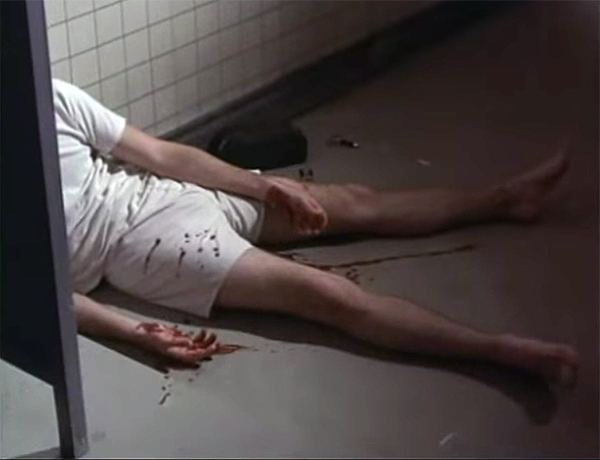
GRADUATION
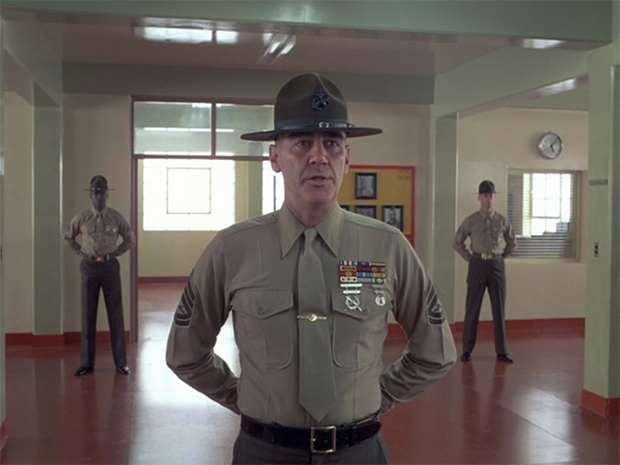
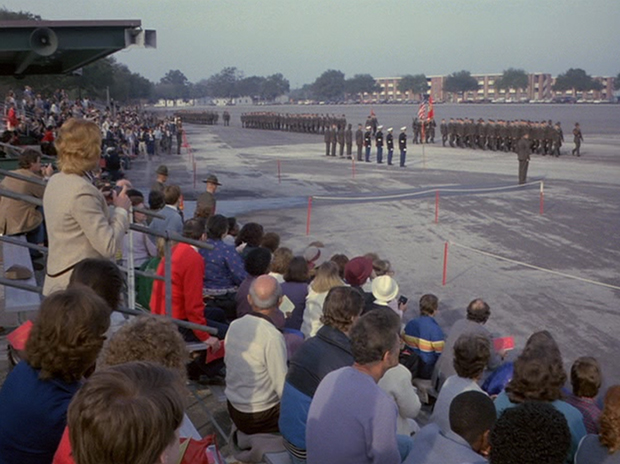
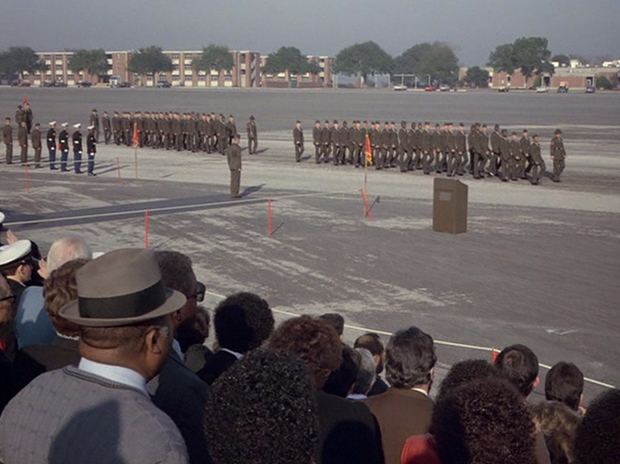
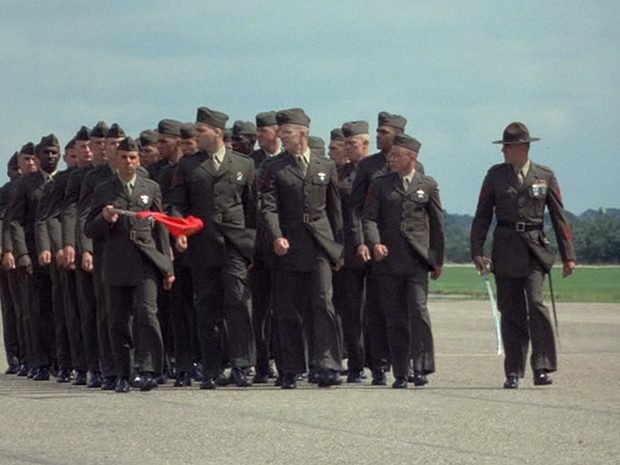
PICKETT (sixth man seated from screen left): Sir, yes, sir.
HARTMAN: 0300, Infantry. Toe Jam.
TOE JAM (11th man standing from screen right, could easily be mistaken as 10th): Sir, yes, sir.
HARTMAN: 0300, Infantry.
ADAMS (3th man from screen left, seated): Sir, yes, sir.
HARTMAN: 1800, Engineers.
You go out and find mines. Cowboy.
HARTMAN: 0300, Infantry.
TAYLOR (off screen): Sir, yes, sir.
HARTMAN: 0300, Infantry. Joker.
HARTMAN: 4212...
PYLE: Sir, yes, sir.
HARTMAN: You forget your fucking name? 0300, Infantry. You made it. Perkins.
PERKINS (off screen): Sir, yes, sir.
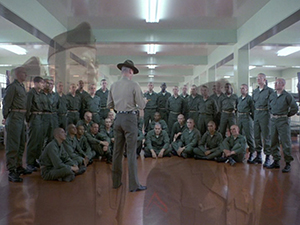
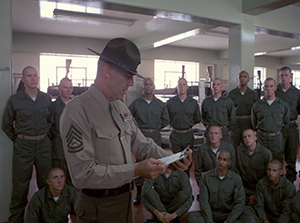

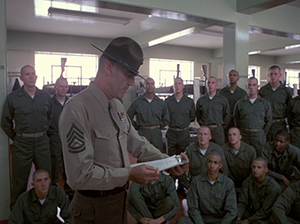






NOTES
PARRIS ISLAND LOCATION SHOTS
This bugs me that two shots are used from what have to be different years, one immediately following the other, and I can't peg the reason for it. The only additional thing I can tell is that the path out to the parade ground is defined on each side by 3 poles and that in shot 171 there are likely 4 poles on each side. The reason I take note of this is because in the following murder/suicide section in shot 210 Pyle sits on the 4th toilet from the end of the room to commit suicide, then in shot 212, of his suicide, he is on the 3rd toilet from the end, and remains on the 3rd toilet from the end in shot 214. Shot 170, at the graduation ceremony, the one with 3 poles, one of which is tipped with white, shows a woman take a photo of the Marines parading, and I have the feeling that the difference might have to do with this.PLATOON 3092
The two views here would appear not to be from before 1969. The Parris Island graduation parades I find from the 1960s, in photos and a couple of videos ( 1967 here and here and January 1969 here) show the graduation parade occurring before two story white buildings rather than three story brick. I believe what we're seeing is the 2nd Battalion housing that is said to have been replaced sometime in the late 1960s, but in January 1969 we still see the white wood buildings. I have also located footage from 1970 and the white wood barracks are still shown, and the styles of clothing and hair of the viewers in the bleachers is more conservative than in the film.
A difference between the novel and film is that in the novel Pyle, Joker and Cowboy are each singled out for an honor on graduation day. Pyle, however a Class A Section Eight, became the "outstanding recruit" and was awarded dress blues, which he is privileged to wear, thus making him stand out among all else. A dramatic, sentimental honor was that the book's D.I. gives Joker his old PFC stripes. Cowboy carried the platoon guidon.
Why would the D.I. give Joker his old PFC stripes? It's almost as if anticipating his death and passing them along as in willing them to him. Considering how brutal the D.I. has been, what's Joker to make of the D.I. awarding him with is old Private First Class stripes, as if transferring to Joker aspects of himself, identifying Joker with himself as a young recruit? But then when he learns that Joker is to become a correspondant he berates him for being a pogue rather than a grunt. In the film he insists to Joker he is a killer instead.
Graduation day. A thousand new Marines stand tall on the parade deck, lean and tan in immaculate khaki, their clean weapons held at port arms.
Leonard is selected as the outstanding recruit from Platoon 30-92. He is awarded a free set of dress blues and is allowed to wear the colorful uniform when the graduating platoons pass in review. The Commandant General of Parris Island shakes Leonard's hand and gives him a "Well done." Our series commander pins a RIFLE EXPERT badge on Leonard's chest and our company commander awards Leonard a citation for shooting the highest score in the training battalion.
Because of a special commendation submitted by Sergeant Gerheim, I'm promoted to Private First Class. After our series commander pins on my EXPERT'S badge, Sergeant Gerheim presents me with two red and green chevrons and explains that they're his old PFC stripes.
When we pass in review, I walk right guide, tall and proud.
Cowboy receives an EXPERT'S badge and is selected to carry the platoon guidon.
The Commanding General of Parris Island speaks into a microphone: "Have you seen the light? The white light? The great light? The guiding light? Do you have the vision?"
And we cheer, happy beyond belief.
The Commanding General sings. We sing too:
Hey, Marine, have you heard?
Hey, Marine...
L.B.J. has passed the word.
Hey, Marine...
Say good-bye to Dad and Mom.
Hey, Marine...
You're gonna die in Viet Nam.
Hey, Marine, yeah!
After the graduation ceremony our orders are distributed. Cowboy, Leonard, Private Barnard, Philips, and most of the other Marines in Platoon 30-92 are ordered to ITR--the Infantry Training Regiment--to be trained as grunts, infantrymen.
My orders instruct me to report to the Basic Military Journalism School at Fort Benjamin Harrison, Indiana, after I graduate from ITR. Sergeant Gerheim is disgusted by the fact that I am to be a combat correspondent and not a grunt. He calls me a poge, an office pinky. He says that shitbirds get all the slack.
Standing at ease on the parade deck, beneath the monument to the Iwo Jima flag raising, Sergeant Gerheim says, "The smoking lamp is lit. You people are no longer maggots. Today you are Marines. Once a Marine, always a Marine..."
Leonard laughs out loud.
As I noted earlier, there is the attempted suicide of Perkins in the novel, and Quentin in Tribes, which has been absorbed into Pyle in the film. The film elects to include the name Perkins as one of the graduates, his name called out by Hartman following his informing Pyle that he has made it into the infantry. We only hear, however, Perkins respond, and don't hear his assignment. That Perkins' name is called after Pyle's, I think we can take as the film's forecasting Pyle's suicide.
183 Joker walks the dark squad bay with a baton and flashlight, then, approaching the camera, enters the hall off the head and the DI's quarters. He stops at the DI's door. Then, drawn to the head, as if hearing noises, he presses open the door with his baton and enters. The "Leonard" piece of the soundtrack has begun. ( 39:57)
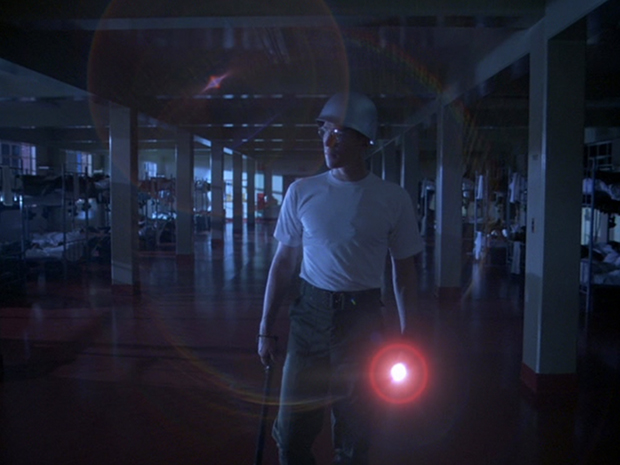
JOKER: Our last night on the island, I draw fire watch.
184 The white light of the flashlight on the wall of the head above the radiators. ( 40:45)
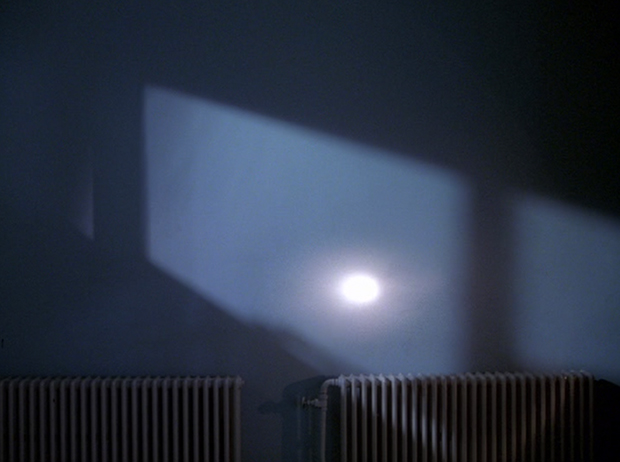
185 MCU of Pyle seated on the 4th toilet from the end, Joker's light shining on him. His rifle rests beside him. He holds a magazine which he is filling with bullets. ( 40:55)
PYLE (looks up at Joker and oddly smiles, breathing deeply in and out): Hi, Joker.
Cut the light of the flashlight on Pyle as he continues filling the magazine.
186 CU of Joker. ( 41:21)
JOKER: Are those live rounds?
187 CU of Pyle. ( 41:32)
PYLE: Seven-six-two millimeter. Full metal jacket.
188 CU of Joker as in 186. ( 41:48)
JOKER: Leonard,.if Hartman comes in here and catches us, we'll both be in a world of shit.
189 CU of Pyle as in 187. ( 42:01)
PYLE: I am...in a world...of shit.
190 Shot down length of bathroom from behind Pyle as he stands and takes up his rifle. ( 42:13)
PYLE (holds the rifle before him): Left shoulder. Huh!
191 MS of Pyle from the front. ( 42:16)
PYLE (after twirling the rifle, places it against his left shoulder, our screen right): Right shoulder. Huh!
192 CU of Joker as in 188. ( 42:22)
PYLE (off screen): Lock and load.
193 Shot down length of bathroom, from behind Pyle, toward Joker. He arms the rifle with the magazine. ( 42:24)
194 CU of Pyle. ( 42:29)
PYLE: Order. Huh! This is my rifle. There are many like it, but this one is mine.
195 A long shot down the dark squad bay from the hall leading to the DI's quarters and the head. Recruits have begun getting out of bed, responding to the commotion. ( 42:37)
PYLE (off screen):
My rifle is my best friend. It is my life.
HARTMAN (emerging from his room, to the men in the squad bay): Get back in your bunks.
Hartman enters the bathroom while the camera stays on the men in the squad bay.
HARTMAN (off screen): What is this Mickey Mouse shit? What in the name of...
196 MS of Joker, from beyond Pyle, as Hartman enters the head. (42:46)
HARTMAN:
Jesus H. Christ are you animals doing in my head? Why is Private Pyle out of his bunk after lights out? Why is Private Pyle holding that weapon? Why aren't you stomping Private Pyle's guts out?
JOKER:
Sir, it is the private's duty to inform the senior drill instructor that Private Pyle has a full magazine and is locked and loaded, sir.
197 CU of Pyle. (43:08)
198 MS, from behind Pyle, of Joker and Hartman, as in 196. (43:13)
HARTMAN: Now you listen to me, Private Pyle, and you listen good. I want that weapon and I want it now. You will place that rifle on the deck at your feet and...
199 CU of Pyle as in 197. (43:31)
HARTMAN (off screen): ...step back away from it.
Pyle, grinning savagely, raises his weapon and points it at Hartman.
200 As in 198, MS from behind Pyle of Hartman and Joker. (43:39)
HARTMAN: What is your major malfunction, numb-nuts? Didn't Mommy and Daddy show you enough attention when you were a child?
201 From behind Hartman, waist level, shot of Pyle firing the gun. (43:47)
202 MCU of Hartman, blood exploding from his chest, Joker in the background. (43:47)
203 CU of Pyle as in 199. (43:49)
204 MS of Hartman as he falls back, Joker watching in astonishment. (43:49)
205 CU of Pyle as in shot 200. (43:53)
206 From beyond Pyle, shot of Hartman on the floor, dead, Joker standing above him. As Joker looks at Pyle, Pyle raises his rifle and points it at him. (43:55)
207 CU of Joker as in shot 192. (44:07)
JOKER: Easy, Leonard. Go easy, man.
208 MS of Pyle still pointing his rifle at Joker, gazing toward the camera. (44:19)
Pyle sits down on the 4th toilet from the end and turns his gaze away from Joker.
209 CU of Joker as in shot 206. (44:36)
 184 |
 185 |
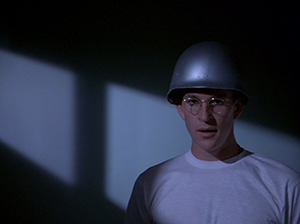 186 |
 187 |
 188 |
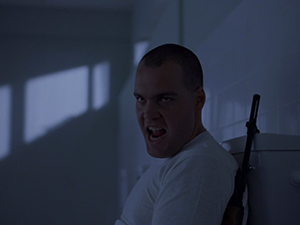 189 |
 190 |
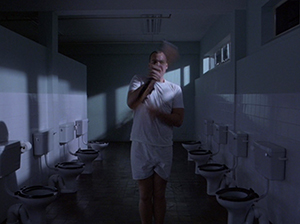 191 |
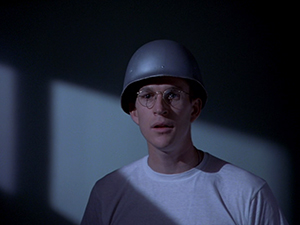 192 |
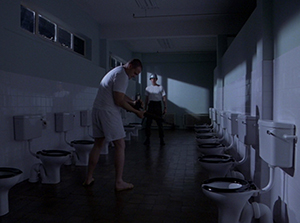 193 |
 194 |
 195 |
 196 |
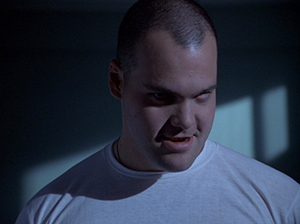 197 |
 198 |
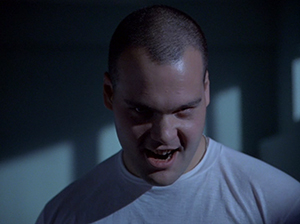 199 |
 200 |
 201 |
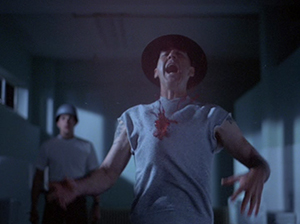 202 |
 203 |
 204 |
 205 |
 206 |
 207 |
 208 |
 209 |
210 MS of Pyle sitting on the toilet, as in 207. He places the gun between his legs and puts the muzzle in his mouth. (44:40)
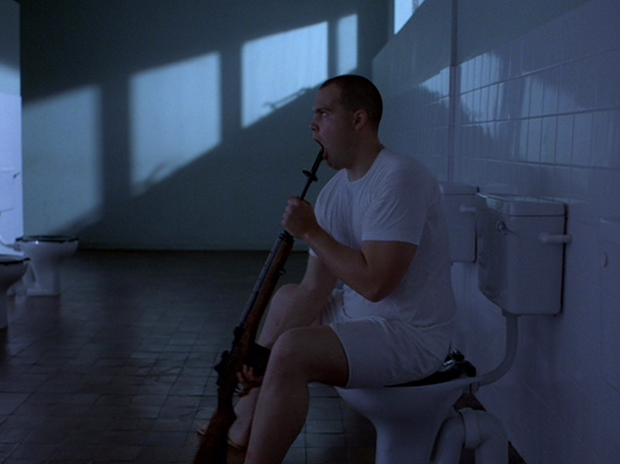
211 CU of Joker as shot 208. (44:41)
JOKER: No!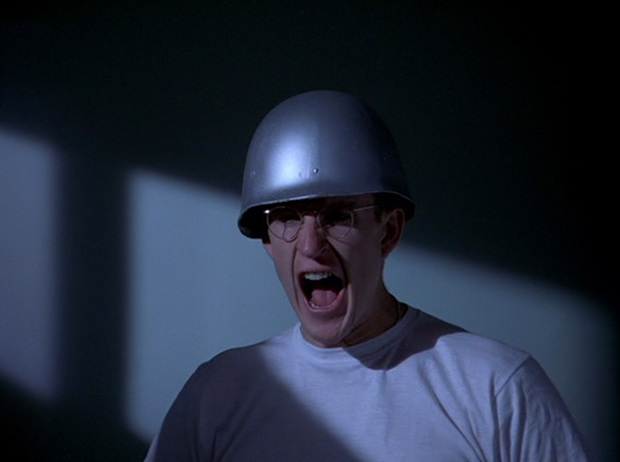
212 MCU of Pyle from the front as he fires the weapon and blood sprays over the wall behind him. He is now seated on the 3rd toilet from the end. (44:42)
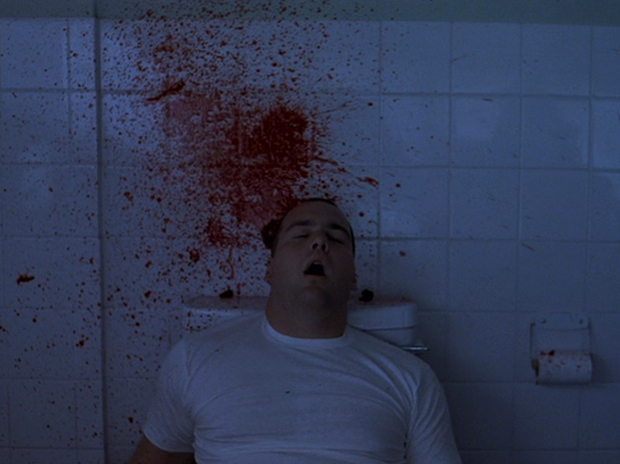
213 CU of Joker as shot 210. He looks down in the direction of Hartman. (44:45)
214 MS of Pyle sitting on the toilet, as in 208, but he is dead, his head resting on the toilet's tank, blood everywhere. He sits now on the 3rd toilet from the end. Fade to black (44:51)
 213 |
 214 |
From the novel:
The drill instructors are proud to see that we are growing beyond their control. The Marine Corps does not want robots. The Marine Corps wants killers. The Marine Corps wants to build indestructible men, men without fear. Civilians may choose to submit or to fight back. The drill instructors leave recruits no choice. Marines fight back or they do not survive. There it is. No slack.
Graduation is only a few days away and the salty recruits of Platoon 30-92 are ready to eat their own guts and then ask for seconds. The moment the Commandant of the Marine Corps gives us the word, we will grab the Viet Cong guerrillas and the battle-hardened North Vietnamese regulars by their scrawny throats and we'll punch their fucking heads off.
The Marine Corps wants killers. It doesn't want an A.I., a computer, a robot. Kubrick doesn't include this perhaps as it would bring HAL of 2001 to mind--who was a killer computer. But Kubrick will open Joker's fire-watch scene in shot 183 with his flashlight turning to the camera and glaring red, and though with a white center, the red will certainly remind of HAL.

I'm going to start off with an extensive quote from the book, on the murder and suicide, because though the film is much the same, it is also quite different. In the novel, the fetishization of the rifle as a female entity, as if the split-off yet wholly internalized feminine aspect of the recruit, is carried to the extreme of Pyle manifesting her, so that it seems to Joker even he can hear a second voice in the barracks, the voice of a woman. Pyle kills the D.I. with her, but then the rifle expresses its own will and to Pyle's horror turns on him and blows him away. The Short-timers does not actually end with the death of the female sniper, but we can understand how Kubrick would have seen Joker's confrontation with the female sniper as the logical end to the film.
Our last night on the island.
I draw fire watch.
I stand by in utility trousers, skivvy shirt, spit-shined combat boots, and a helmet liner which has been painted silver.
Sergeant Gerheim gives me his wristwatch and a flashlight. "Good night, Marine."
I march up and down the squad bay between two perfectly aligned rows of racks.
One hundred young Marines breathe peacefully as they sleep--one hundred survivors from our original hundred and twenty.
Tomorrow at dawn we'll all board cattle-car buses for the ride to Camp Geiger in North Carolina. There, ITR--the infantry training regiment. All Marines are grunts, even though some of us will learn additional military skills. After advanced infantry training we'll be allowed pogey bait at the slop chute and we'll be given weekend liberty off the base and then we'll receive assignments to our permanent duty stations.
The squad bay is as quiet as a funeral parlor at midnight. The silence is disturbed only by the soft creak-creak of bedsprings and an occasional cough.
It's almost time for me to wake my relief when I hear a voice. Some recruit is talking in his sleep.
I stop. I listen. A second voice. Two guys must be swapping scuttlebutt. If Sergeant Gerheim hears them it'll be my ass. I hurry toward the sound.
It's Leonard. Leonard is talking to his rifle. But there is also another voice. A whisper. A cold, seductive moan. It's the voice of a woman.
Leonard's rifle is not slung on his rack. He's holding his rifle, hugging it. "Okay, okay. I love you!" Very softly: "I've given you the best months of my life. And now you--" I snap on my flashlight. Leonard ignores me. "I LOVE YOU! DON'T YOU UNDERSTAND? I CAN DO IT. I'LL DO ANYTHING!"
Leonard's words reverberate down the squad bay. Racks squeak. Someone rolls over. One recruit sits up, rubs his eyes.
I watch the far end of the squad bay. I wait for the light to go on inside Sergeant Gerheim's palace.
I touch Leonard's shoulder. "Hey, shut your mouth, Leonard. Sergeant Gerheim will break my back."
Leonard sits up. He looks at me. He strips off his skivvy shirt and ties it around his face to blindfold himself. He begins to field-strip his weapon. "This is the first time I've ever seen her naked." He pulls off the blindfold. His fingers continue to break down the rifle into components. Then, gently, he fondles each piece. "Just look at that pretty trigger guard. Have you ever seen a more beautiful piece of metal?" He starts snapping the steel components back together. "Her connector assembly is so beautiful..."
Leonard continues to babble as his trained fingers reassemble the black metal hardware.
I think about Vanessa, my girl back home. We're on a river bank, wrapped in an old sleeping bag, and I'm fucking her eyes out. But my favorite fantasy has gone stale. Thinking about Vanessa's thighs, her dark nipples, her full lips doesn't give me a hard-on anymore. I guess it must be the saltpeter in our food, like they say.
Leonard reaches under his pillow and comes out with a loaded magazine. Gently, he inserts the metal magazine into his weapon, into Charlene.
"Leonard...where did you get those live rounds?"
Now a lot of guys are sitting up, whispering, "What's happening?" to each other.
Sergeant Gerheim's light floods the far end of the squad bay.
"OKAY, LEONARD, LET'S GO." I'm determined to save my own ass if I can, certain that Leonard's is forfeit in any case. The last time Sergeant Gerheim caught a recruit with a live round--just one round--he ordered the recruit to dig a grave ten feet long and ten feet deep. The whole platoon had to fall out for the "funeral." I say, "You're in a world of shit now, Leonard."
The overhead lights explode. The squad bay is washed with light. "WHAT'S THIS MICKEY MOUSE SHIT? JUST WHAT IN THE NAME OF JESUS H. CHRIST ARE YOU ANIMALS DOING IN MY SQUAD BAY?"
Sergeant Gerheim comes at me like a mad dog. His voice cuts the squad bay in half: "MY BEAUTY SLEEP HAS BEEN INTERRUPTED, LADIES. YOU KNOW WHAT THAT MEANS. YOU HEAR ME, HERD? IT MEANS THAT ONE RECRUIT HAS VOLUNTEERED HIS YOUNG HEART FOR A GODDAMN HUMAN SACRIFICE!'
Leonard pounces from his rack, confronts Sergeant Gerheim.
Now the whole platoon is awake. We all wait to see what Sergeant Gerheim will do, confident that it will be worth watching.
"Private Joker. You shitbird. Front and center."
I move my ass. "AYE-AYE, SIR!"
"Okay, you little maggot, speak. Why is Private Pyle out of his rack after lights out? Why is Private Pyle holding that weapon? Why ain't you stomping Private Pyle's guts out?"
"SIR, it is the Private's duty to report to the drill instructor that Private...Pyle...has a full magazine and has locked and loaded, SIR."
Sergeant Gerheim looks at Leonard and nods. He sighs. Gunnery Sergeant Gerheim looks more than a little ridiculous in his pure white skivvies and red rubber flip-flop shower shoes and hairy legs and tattooed forearms and a beer gut and a face the color of raw beef, and, on his bald head, the green and brown Smokey the Bear campaign cover.
Our senior drill instructor focuses all of his considerable powers of intimidation into his best John-Wayne-on Suribachi voice: "Listen to me, Private Pyle. You will place your weapon on your rack and--"
"NO! YOU CAN'T HAVE HER! SHE'S MINE! YOU HEAR ME? SHE'S MINE! I LOVE HER!"
Gunnery Sergeant Gerheim can't control himself any longer. "NOW YOU LISTEN TO ME, YOU FUCKING WORTHLESS LITTLE PIECE OF SHIT. YOU WILL GIVE ME THAT WEAPON OR I'M GOING TO TEAR YOUR BALLS OFF AND STUFF THEM DOWN YOUR SCRAWNY LITTLE THROAT! YOU HEAR ME, MARINE? I'M GOING TO PUNCH YOUR FUCKING HEART OUT!"
Leonard aims the weapon at Sergeant Gerheim's heart, caresses the trigger guard, then caresses the trigger...
Sergeant Gerheim is suddenly calm. His eyes, his manner are those of a wanderer who has found his home. He is a man in complete control of himself and of the world he lives in. His face is cold and beautiful as the dark side surfaces. He smiles. It is not a friendly smile, but an evil smile, as though Sergeant Gerheim were a werewolf baring its fangs. "Private Pyle, I'm proud--"
Bang.
The steel buttplate slams into Leonard's shoulder.
One 7.62-millimeter high-velocity copper-jacketed bullet punches Gunnery Sergeant Gerheim back.
He falls.
We all stare at Sergeant Gerheim. Nobody moves.
Sergeant Gerheim sits up as though nothing has happened. For one second, we relax. Leonard has missed. Then dark blood squirts from a little hole in Sergeant Gerheim's chest. The red blood blossoms into his white skivvy shirt like a beautiful flower. Sergeant Gerheim's bug eyes are focused upon the blood rose on his chest, fascinated. He looks up at Leonard. He squints. Then he relaxes. The werewolf smile is frozen on his lips.
My menial position of authority as the fire watch on duty forces me to act. "Now, uh, Leonard, we're all your bros, man, your brothers. I'm your bunkmate, right? I--"
"Sure," says Cowboy.
"Go easy, Leonard. We don't want to hurt you."
"Affirmative," says Private Barnard.
Leonard doesn't hear. "Did you see the way he looked at her? Did you? I knew what he was thinking. I knew. That fag pig and his dirty--"
"Leonard..."
"We can kill you. You know that." Leonard caresses his rifle. "Don't you know that Charlene and I can kill you all?"
Leonard aims his rifle at my face.
I don't look at the rifle. I look into Leonard's eyes.
I know that Leonard is too weak to control his instrument of death. It is a hard heart that kills, not the weapon. Leonard is a defective instrument for the power that is flowing through him. Sergeant Gerheim's mistake was in not seeing that Leonard was like a glass rifle which would shatter when fired. Leonard is not hard enough to harness the power of an interior explosion to propel the cold black bullet of his will.
Leonard is grinning at us, the final grin that is on the face of death, the terrible grin of the skull.
The grin changes to a look of surprise and then to confusion and then to terror as Leonard's weapon moves up and back and then Leonard takes the black metal barrel into his mouth. "NO! Not--"
Bang.
Leonard is dead on the deck. His head is now an awful lump of blood and facial bones and sinus fluids and uprooted teeth and jagged, torn flesh. The skin looks plastic and unreal.<
The civilians will demand yet another investigation, of course. But during the investigation the recruits of Platoon 30-92 will testify that Private Pratt, while highly motivated, was a ten percenter who did not pack the gear to be a Marine in our beloved Corps.
Sergeant Gerheim is still smiling. He was a fine drill instructor. Dying, that's what we're here for, he would have said--blood makes the grass grow. If he could speak, Gunnery Sergeant Gerheim would explain to Leonard why the guns that we love don't love back. And he would say, "Well done."
I turn off the overhead lights.
I say, "Prepare to mount." Then: "MOUNT!"
The platoon falls into a hundred racks.
I feel cold and alone. I am not alone. All over Parris Island there are thousands and thousands of us. And, all around the world, hundreds of thousands.
I try to sleep...
In my rack, I pull my rifle into my arms. She talks to me. Words come out of the wood and metal and flow into my hands. She tells me what to do.
My rifle is a solid instrument of death. My rifle is black steel. Our human bodies are bags of blood, easy to puncture and quick to drain, but our hard tools of death cannot be broken.
I hold by weapon at port arms, gently, as though she were a holy relic, a magic wand wrought with interlocking pieces of silver and iron, with a teakwood stock, golden bullets, a crystal bolt, jewels to sight with. My weapon obeys me. I'll hold Vanessa, my rifle. I'll hold her. I'll just hold her for a little while. I will hide in this dark dream for as long as I can.
Blood pours out of the barrel of my rifle and flows up on to my hands. The blood moves. The blood breaks up into living fragments. Each fragment is a spider. Millions and millions of tiny red spiders of blood are crawling up my arms, across my face, into my mouth...
Silence. In the dark, a hundred men are breaking in unison.
I look at Cowboy, then at Private Barnard. They understand. Cold grins of death are frozen on their faces. They nod.
The newly minted Marines in my platoon stand to attention, horizontal in their racks, their weapons at port arms.
The Marines wait, a hundred young werewolves with guns in their hands.
I lead:
This is my rifle.
There are many like it, but this one is mine...
This is more surreal than realistic. Though we're supposed to take this scene as having occurred, that it's not a figment of the imagination, it is also, as it's written, an impossible scene. We can't imagine, after such a murder-suicide, Joker and the entire barracks lying back down to go to sleep. And, as I've read others with Marine Corps knowledge complain, in respect of the murder-suicide in the film, Pyle would not have had access to rifles. From what I read, the graduates might not even be in the squad bay on graduation night.
I find in a Recruit Training Order Manual: Service rifles and SL-3 gear will be returned to the Depot Armory prior to graduation in accordance with the training schedule.
So none of these men would be lying on their racks with their rifles. Even if Pyle had somehow found a way to smuggle his weapon into the head, Joker would certainly not, at the end, lie in his rack hugging his rifle close to him. Gustav has written a surrealist scene that couldn't have taken place--and perhaps, in a way, that he wrote it this way provided a measure of safety, for the murder-suicide must be impossible. Gustave even suggestively calls it "a dark dream".
This is a dream. While it is also real. It is the truth concealed by the real world.
The logical conclusion to a Marine Corps that is built to fight back against anything in order to survive, while being wholly prepared to die, understanding its job is to both kill in order to survive, and be sacrificed, is to turn on the hand that has fed it this rotten world, and to also ultimately commit suicide. One is given the impression that the D.I. is knowledgable that he has constructed the model Marine in Pyle, who must turn on him now, as the enemy, and kill him, and that he probably knows that afterward Pyle's rifle must then turn on Pyle.
This is fiction based on Gustav Hasford's experience as a Marine, and Gustav, who has lived this some version of this, expects the audience to be able to handle fiction that is impossible, real, and a dark dream.
Kubrick begins the nightmare by taking us to the beginning of the film, The D.I., with its statement about the recruit having seen the white light.
D.I.: You got started out on the wrong foot, didn't you? You started out on the right foot instead of the left. But you're squared away now, aren't you? You saw the great light...the white light...the guiding light. You got the vision? You gonna be a good marine? All right, get out of here.""
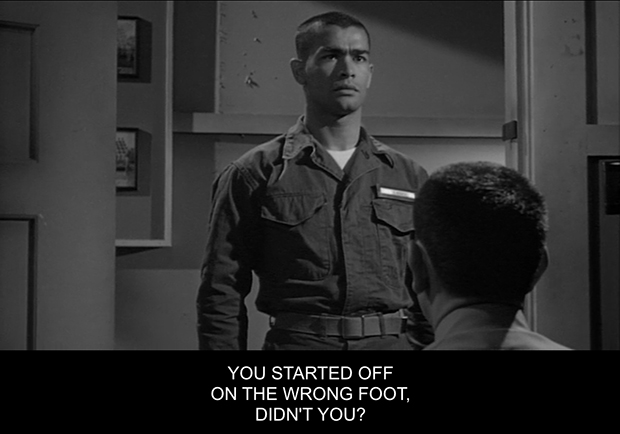
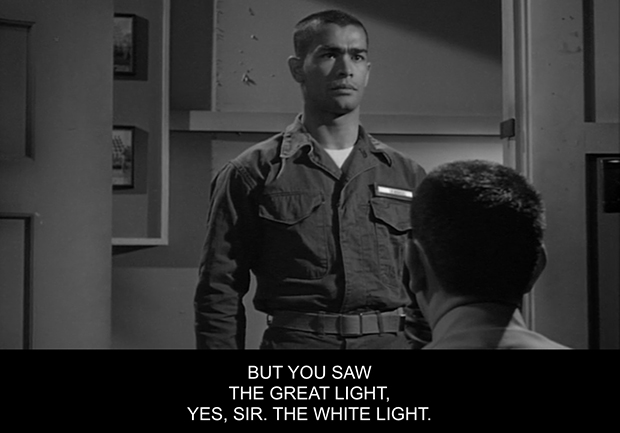
In Gustav's novel, when Hartman is busting Joker down for professing not to believe in the Virgin Mary, when Joker refuses to reverse his position (as any answer will be wrong) Hartman asks him, "Have you seen the light? The white light? The great light? The guiding light--do you have the vision?" Joker says he has and Hartman makes him squad leader. The line is repeated again in the book on graduation day, the Commanding General addressing everyone, "Have you seen the light? The white light? The great light? The guiding light? Do you have the vision?" Both these mentions of the great white light are retained in the screenplay--in Virgin Mary scene, and the graduation day scene--yet are excised from the film. Instead, Kubrick reframes "the great white light" so we observe it in the head.

Note how the light of the flashlight is different in shot 183, when it shines first on the D.I.'s door, then the door of the head, from as it appears in shot 184 on the wall of the head. I have written about this effect, as it appears on the door of the head, in The Shining, and 2001, concerning vanishing point perspective and Kubrick's monolith, when viewed from below, revealing its resolution into the vanishing point, that vanishing point in Kubrick's films sometimes replaced with a bright light. In 2001 it's the sun...though the sun in preceding shots is revealed as nowhere in a position in relationship to the monolith to be observed directly above it. For instance, we also see it in The Shining in the inclusion of Coville's painting of "Horse and Train", in which the horse runs down the tracks toward the bright light of an oncoming train.
We are given the opportunity to observe how, when Joker opens the door, the light naturally elongates. Then, in the head the light has changed. It is a single point of bright white shining on the wall, then as Joker enters from the right the light moves but retains the integrity of its shape, immediately replaced with a bright white beam pointed at the camera as Joker faces us. We observe the light briefly on Pyle before Joker cuts off the flashlight.
We see a single bright light beyond Jack, toward the end of The Shining, when he settles down to freeze, unable to find Danny, who has escaped the maze in which Jack is trapped. We should certainly compare this shot with Pyle seated upon the toilet.
As for the transfer of this scene from, in the book, the rack area, to the head in the film, we might glimpse the original location with the slashes of light and shadow on the head's wall, formed by its windows, mimicking the columns in the squad bay ard the spaces between. We might also imagine in these the "stairway to heaven" ladder of the obstacle course. This is of significance, that we can see the columns of the squad bay in the shadows on the head's walls. because it takes us back to shots 158 and 159, in which we see in shot 158 Pyle swabbing the center floor of the squad bay, between the columns, and then in shot 159 we are shown Joker and Cowboy swabbing the head in the area where Pyle kills Hartman and shoots himself, and Joker is telling Cowboy that Pyle talks to his rifle. We may then drop back further to shots 61 through 74, the section in which the recruits first take their rifles to bed with them and recite the Riflemen's Creed, which Pyle recites in part here in shots 194 and 195, duplicating the lines recited in shot 68. "This is my rifle. There are many like it, but this one is mine. My rifle is my best friend. It is my life." At the end of that section we were shown Joker's counterpart, another individual who'd pulled fire watch, standing before the head. Returning to that scene, Kubrick is giving a psycho-geographical way in which to explain Pyle's ability to have the rifle, in much the same way that in Eyes Wide Shut he shows how the mask, which Bill locked away in the cabinet of his office, found its way onto his pillow. With Bill's locking away of the bag containing the mask, Kubrick had crossfaded over to Alice asleep in bed, and Bill is positioned so that when he is locking away the Rainbow bag he is also placing it on the pillow. Alice then wakes from a dream she's having--a nightmare--and recounts it to Bill. Unsettlingly, in the dream she had been having sex with a number of men in a place where many people were watching and having sex, which must remind Bill of his visit to Somerton. It's as if Kubrick is attempting to work out in film something about unconscious processing (even a kind of unconscious communal terrain) which doesn't follow the rationality of the daylight world but which follows an unconscious sense of order.
Gustav, in The Short-timers, doesn't describe what the great, white light means, nor to have the "vision", just as it's not explained in The D.I., nor does Kubrick explain the great, white light and its meaning. What we do know is that despite his becoming a killer, perhaps even the model recruit that Hartman has been waiting on to appear and murder him, he has not bonded with his peers due the way he was alienated by Hartman. He's a Section Eight that Hartman refused to cull from the platoon, determined to not be defeated by Pyle, and making of him a model marksman. Hartman is killed because of this. That Pyle's rifle, as his internalized feminine aspect, becomes his enemy and turns on him, so that it isn't Pyle that shoots himself, but the rifle, is left out by Kubrick, but is an idea that will later assert itself in the scene between Joker and the sniper, when his rifle malfunctions and he is left to face the female sniper without it.
In the book, Joker explains that he knows Pyle is defective because his heart isn't hard enough. He's too weak to control the rifle. Thus he is killed by it. Kubrick doesn't make this judgment. Instead, rather than shoot Joker, a rack mate who had betrayed him, Pyle sits down, puts his rifle to his mouth and then rather impossibly pulls the trigger, for his arm is too short to reach it. In this way, Pyle's arm being too short to reach the trigger, that Kubrick does communicate the volition of the rifle, as in the novel, but it appears to be in agreement with Pyle here, whereas Pyle is shocked in the book and cries out not to be shot by it, surprised that the rifle turns on him. He yells, "No!" The screenplay ends the scene as in the novel, with Pyle surprised as the rifle turns on him. Not so in the film. Pyle shoots himself with the co-operation of the rifle, and the "No!" is given to Joker to exclaim.
Approx 17,100 words or 34 single-spaced pages.
Next: Full Metal Jacket Analysis - Part 3
Go to Table of Contents for Analysis of "Full Metal Jacket"
Link to the main TOC page for all the analyses